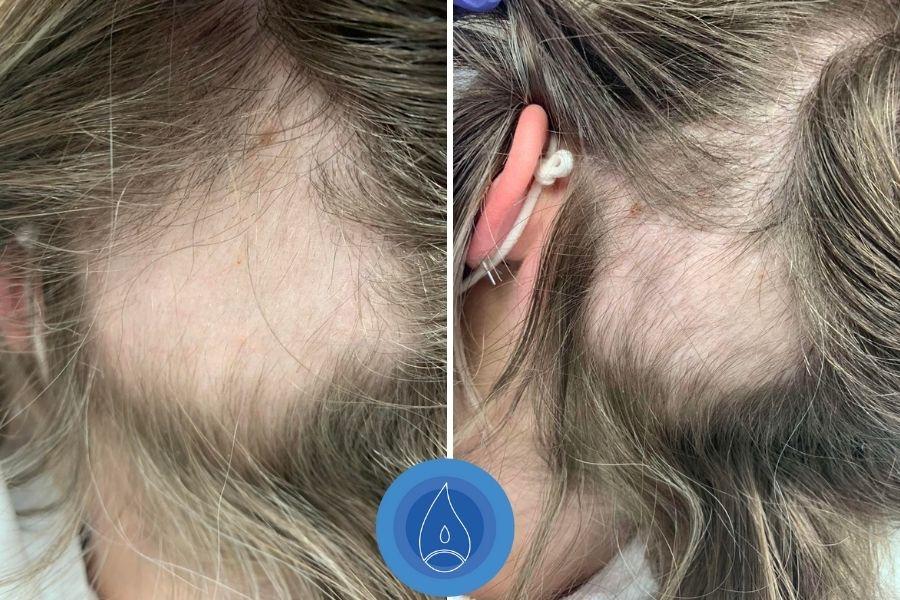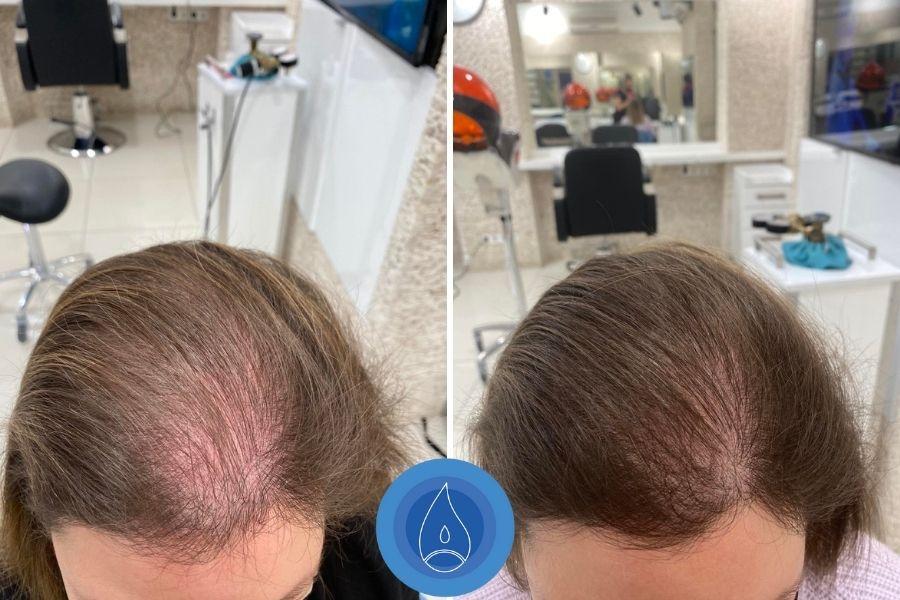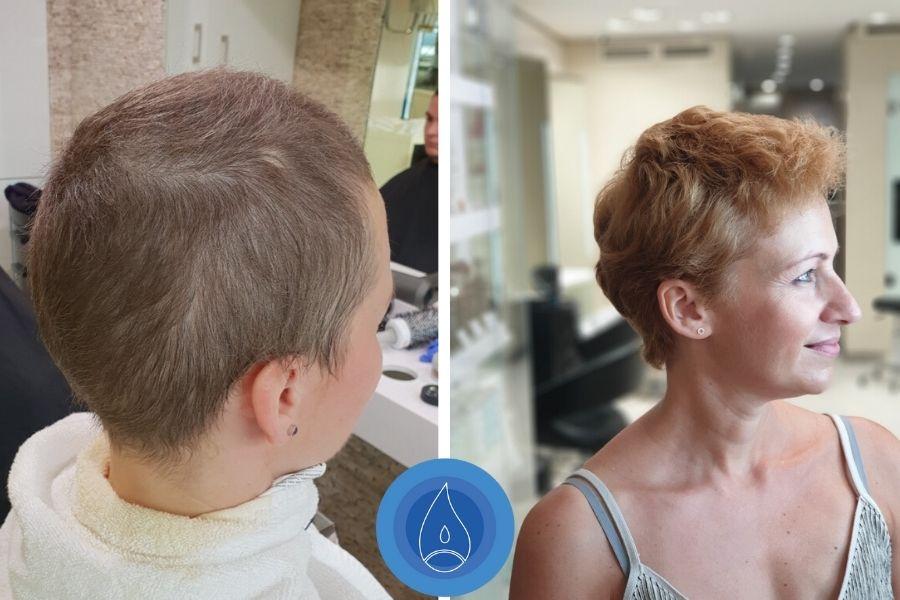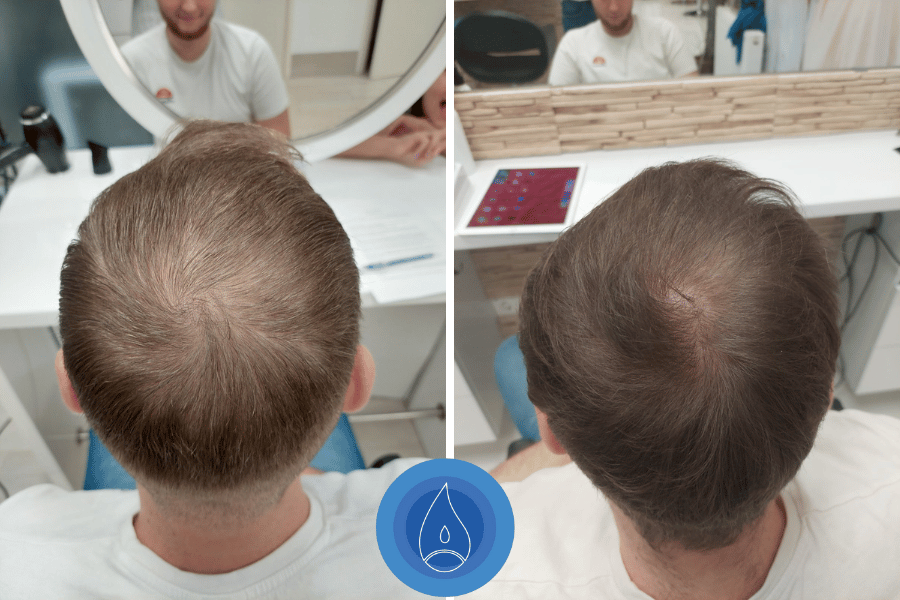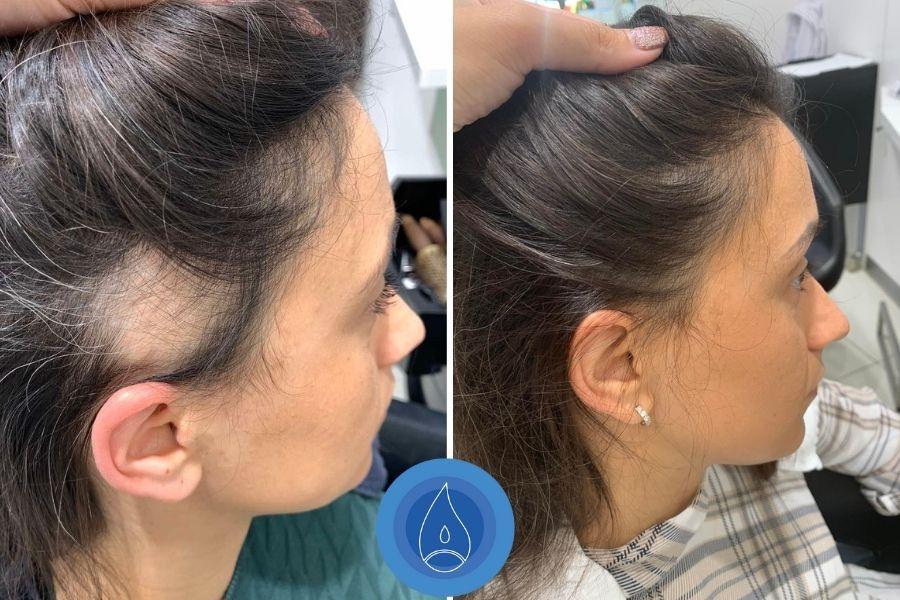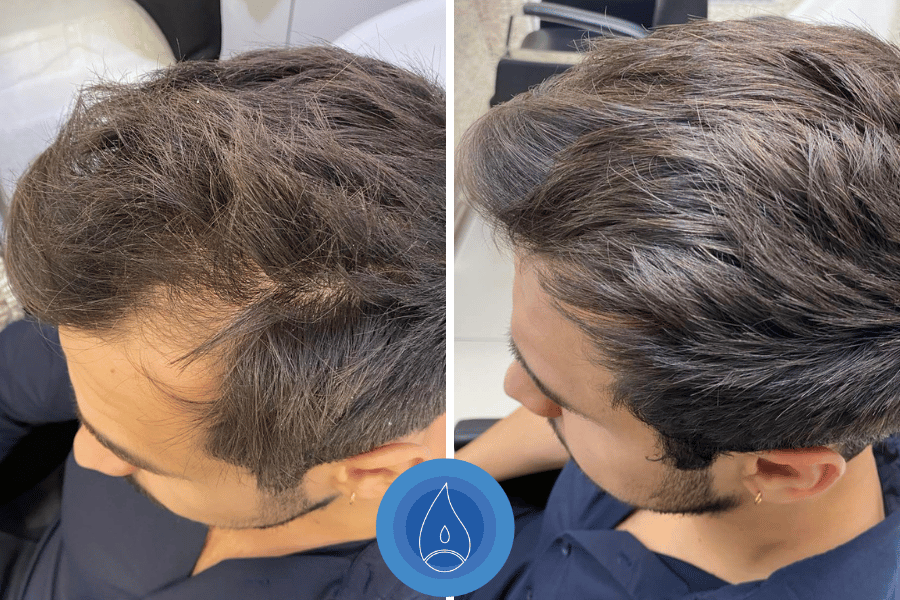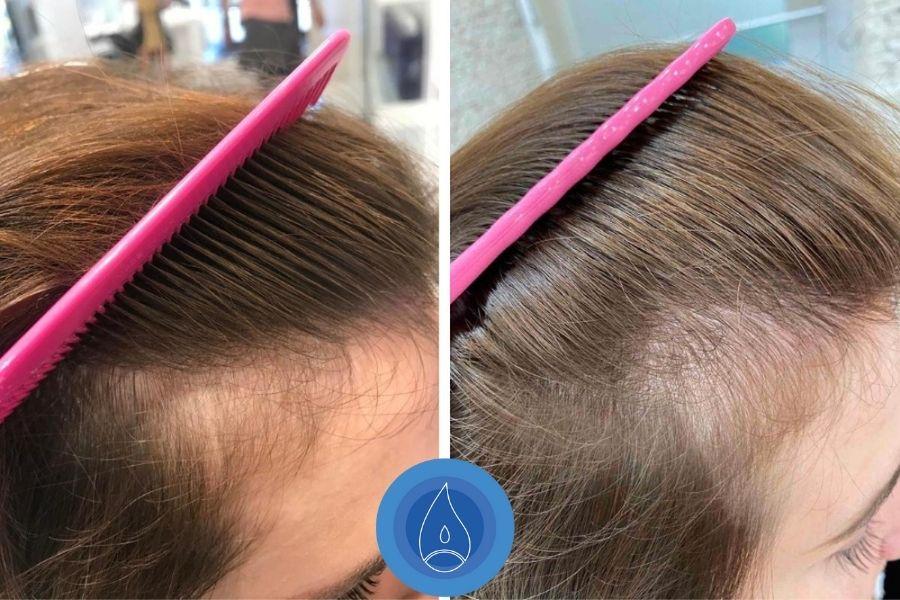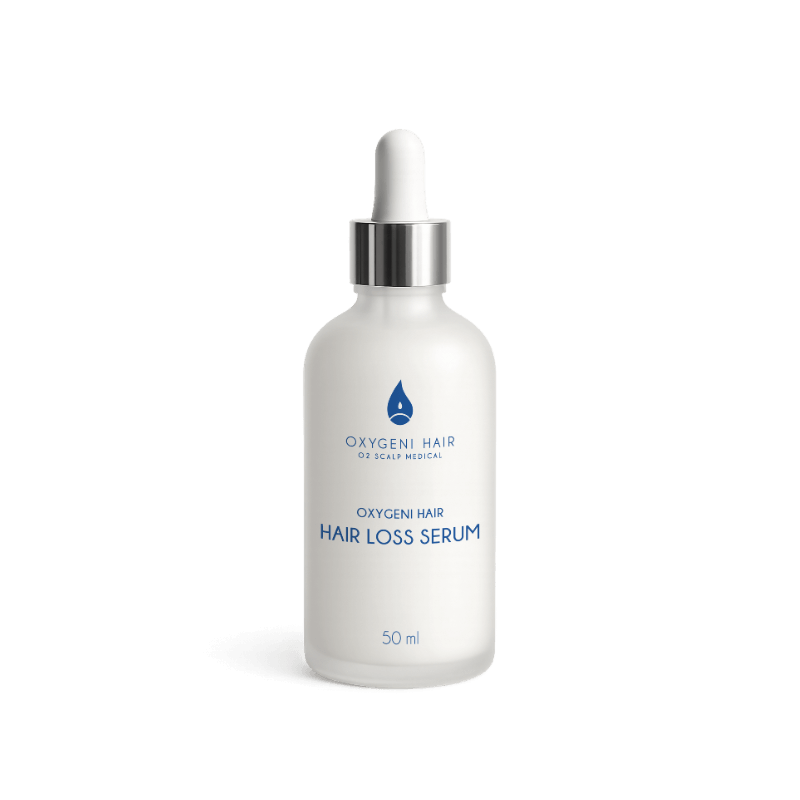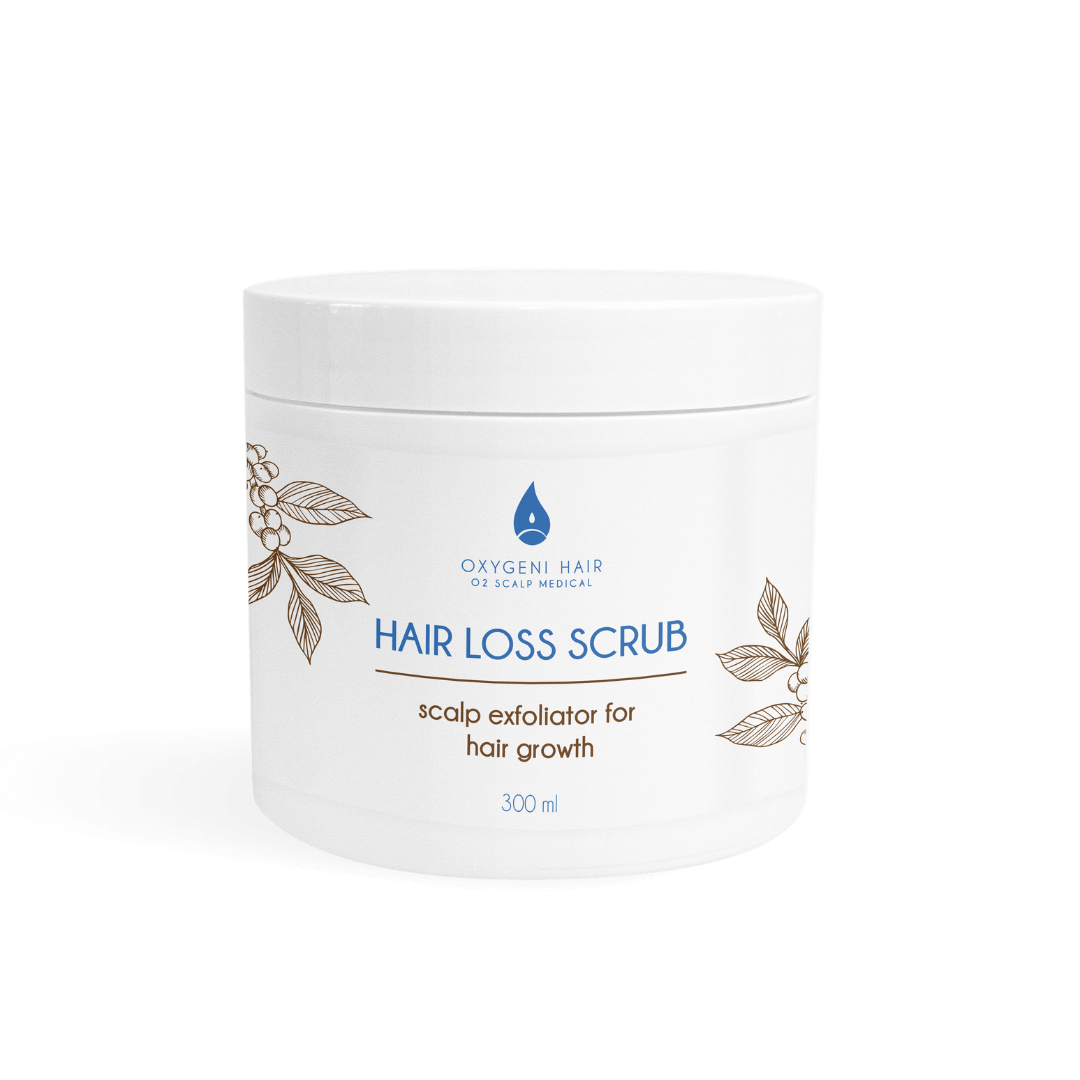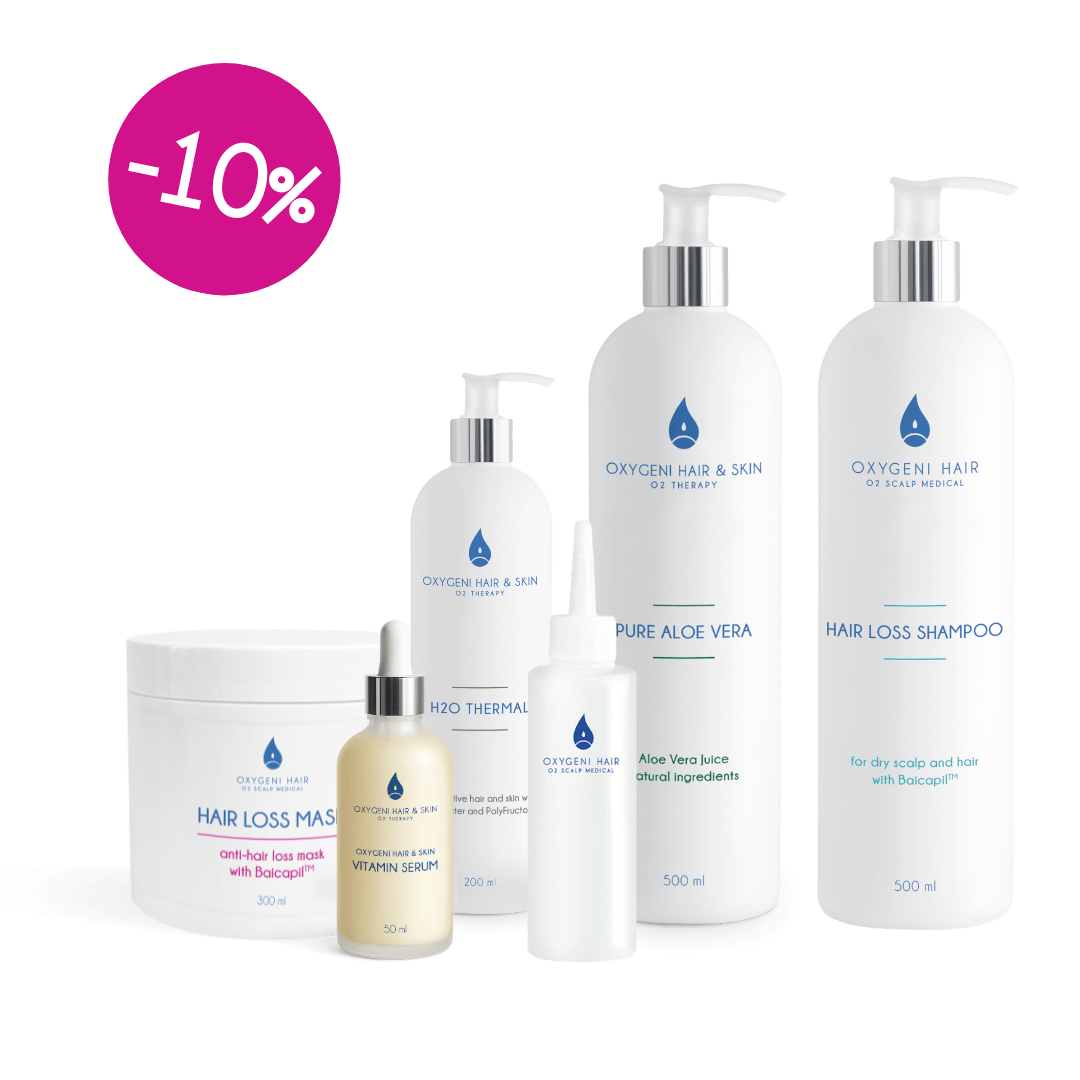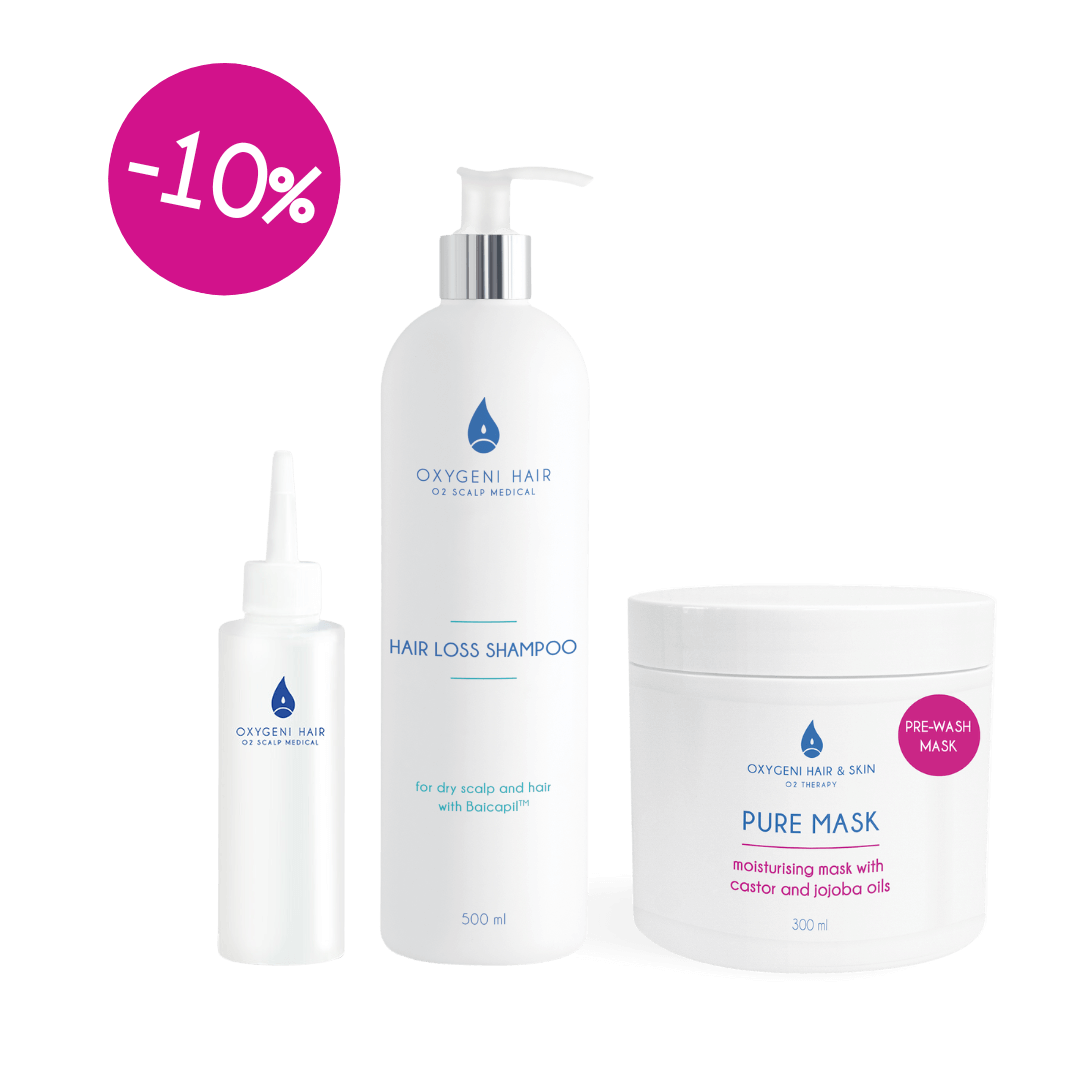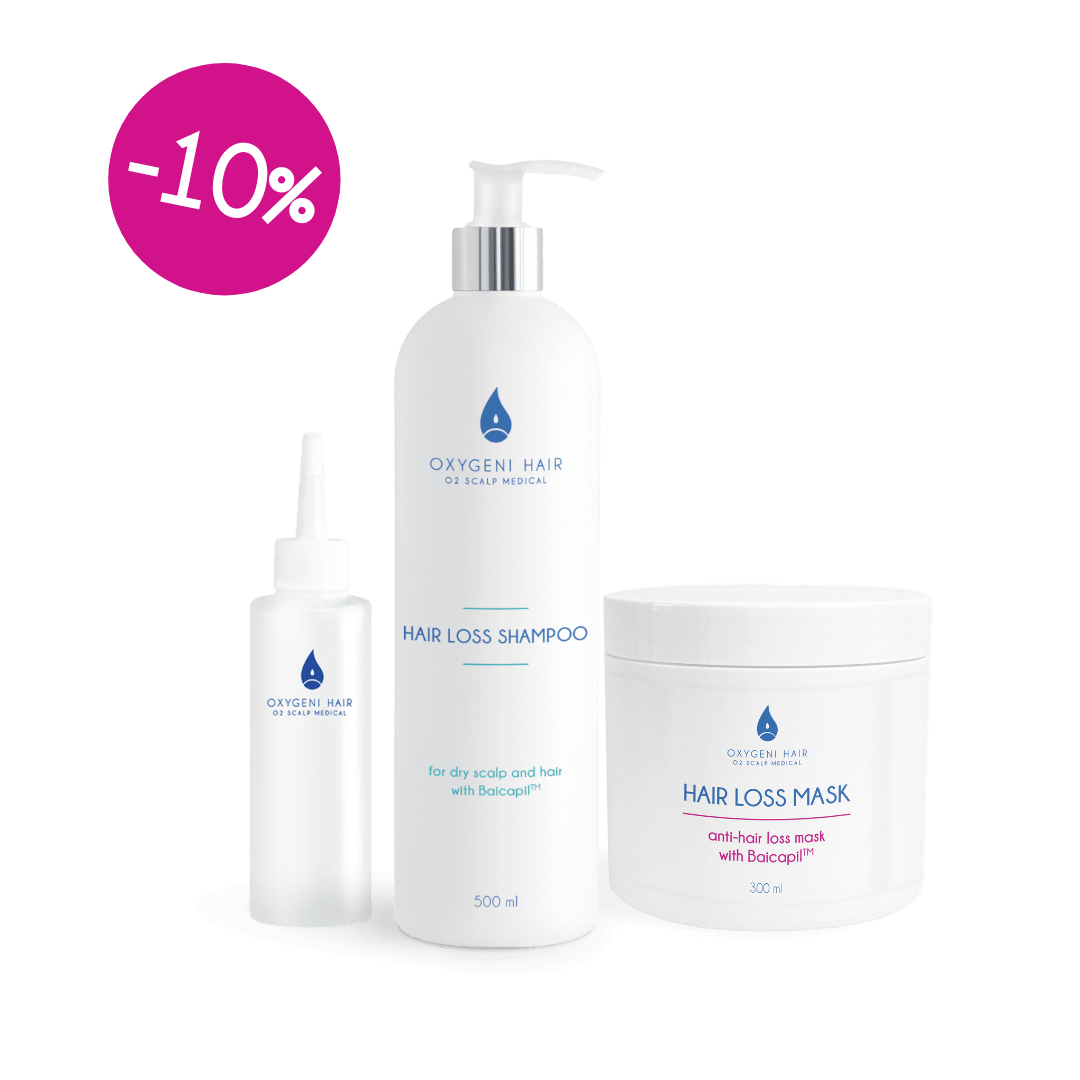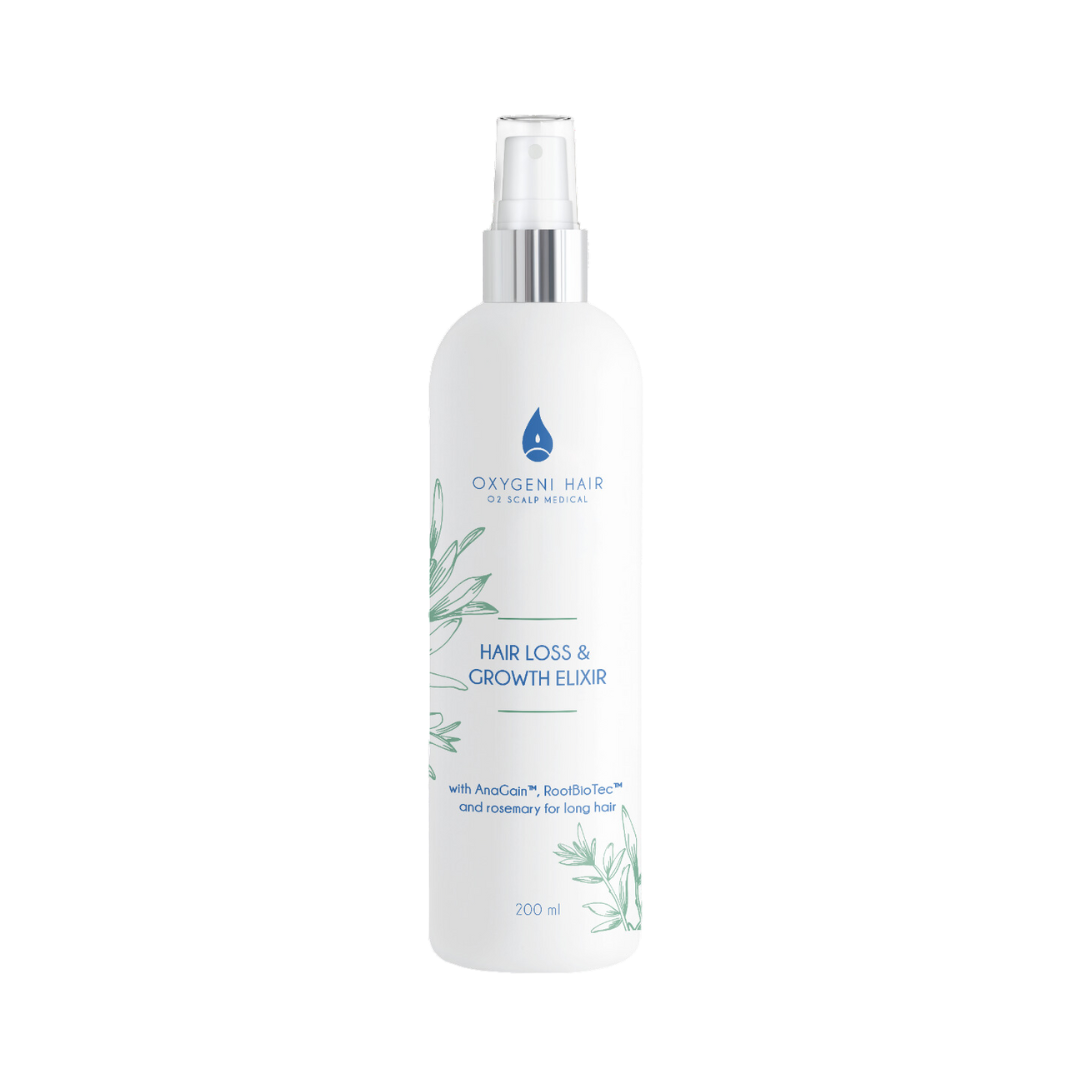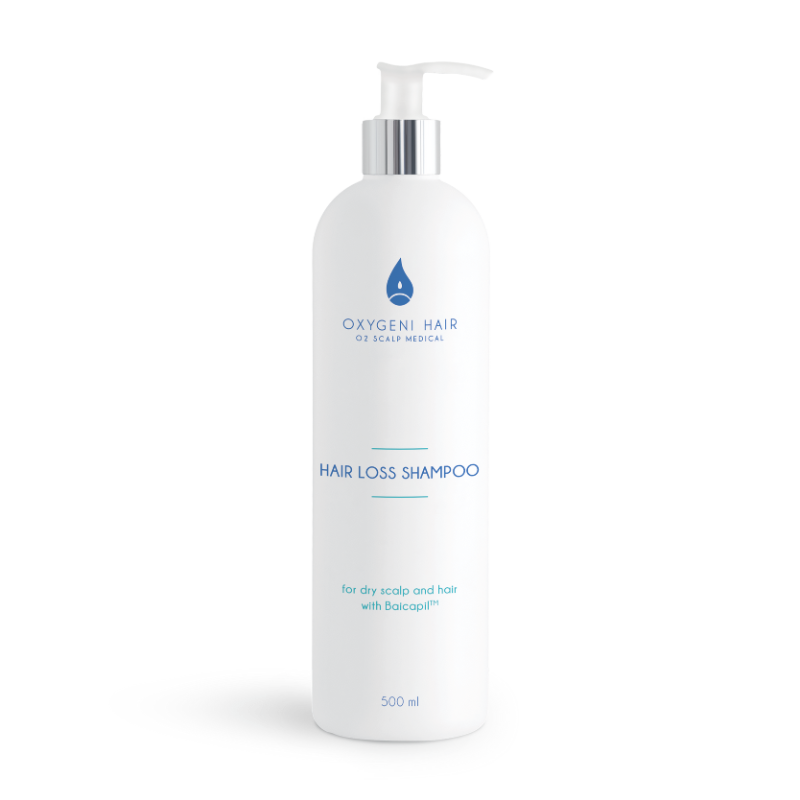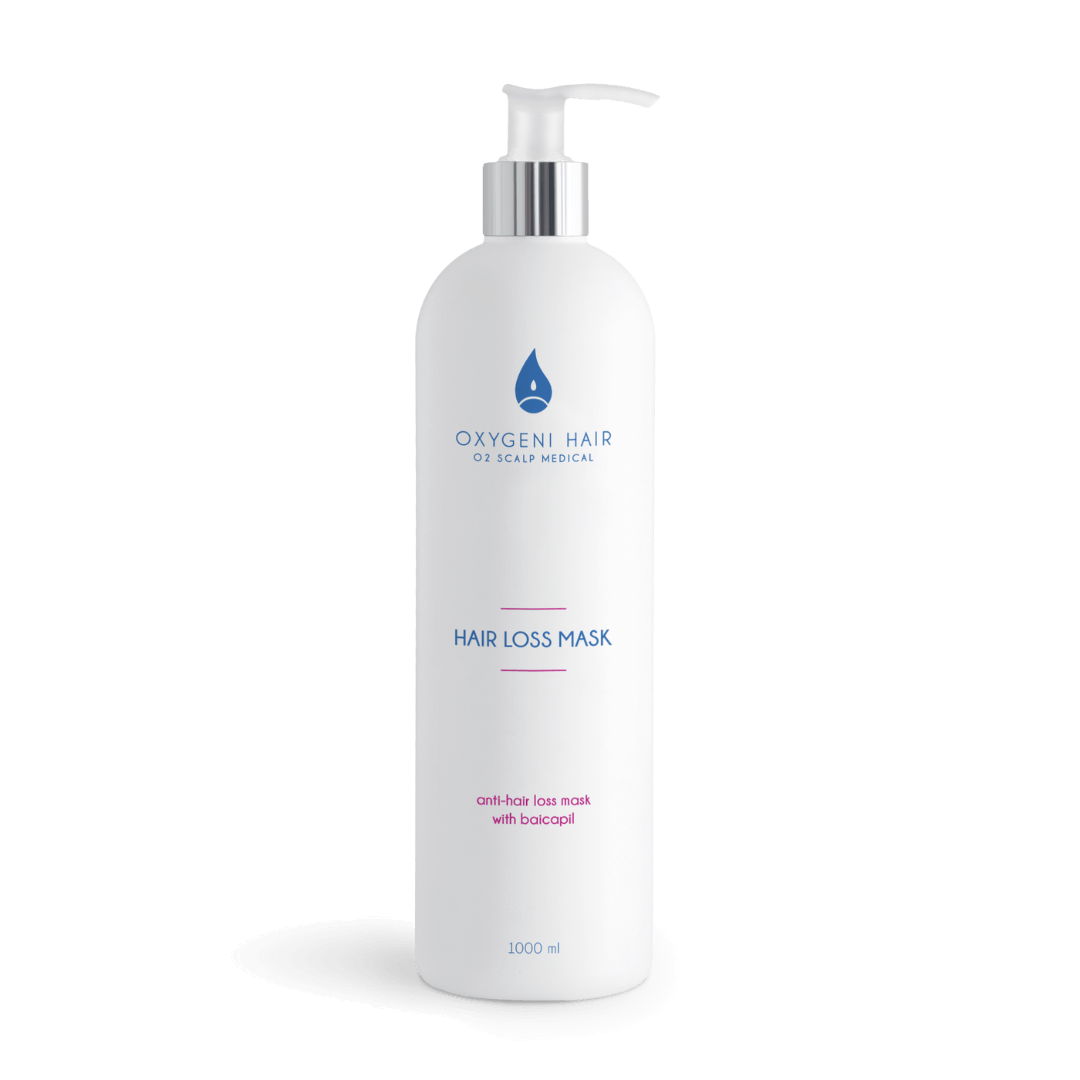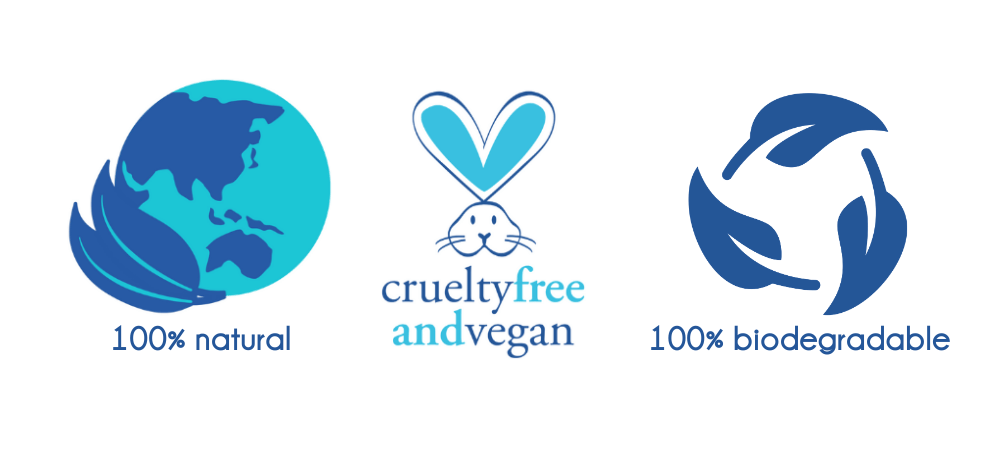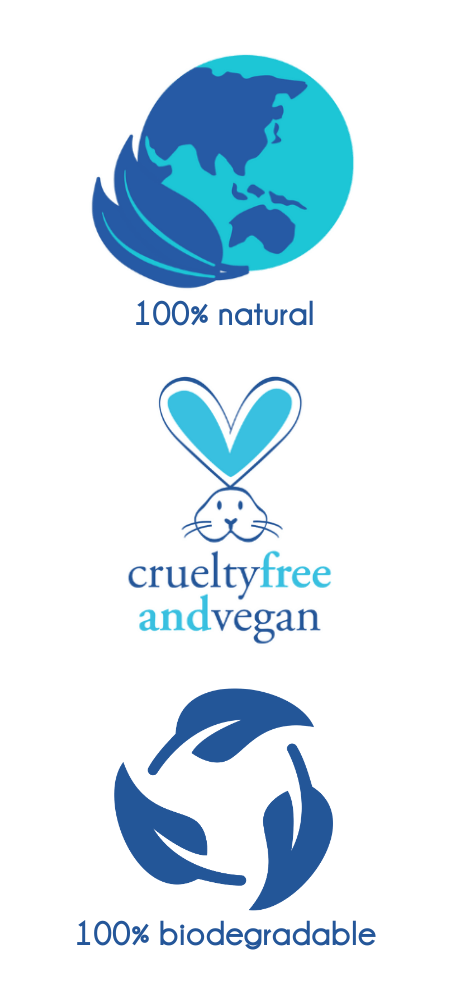Hair loss treatment
Hair Loss Treatment
The causes of hair loss, treatments, and hair growth
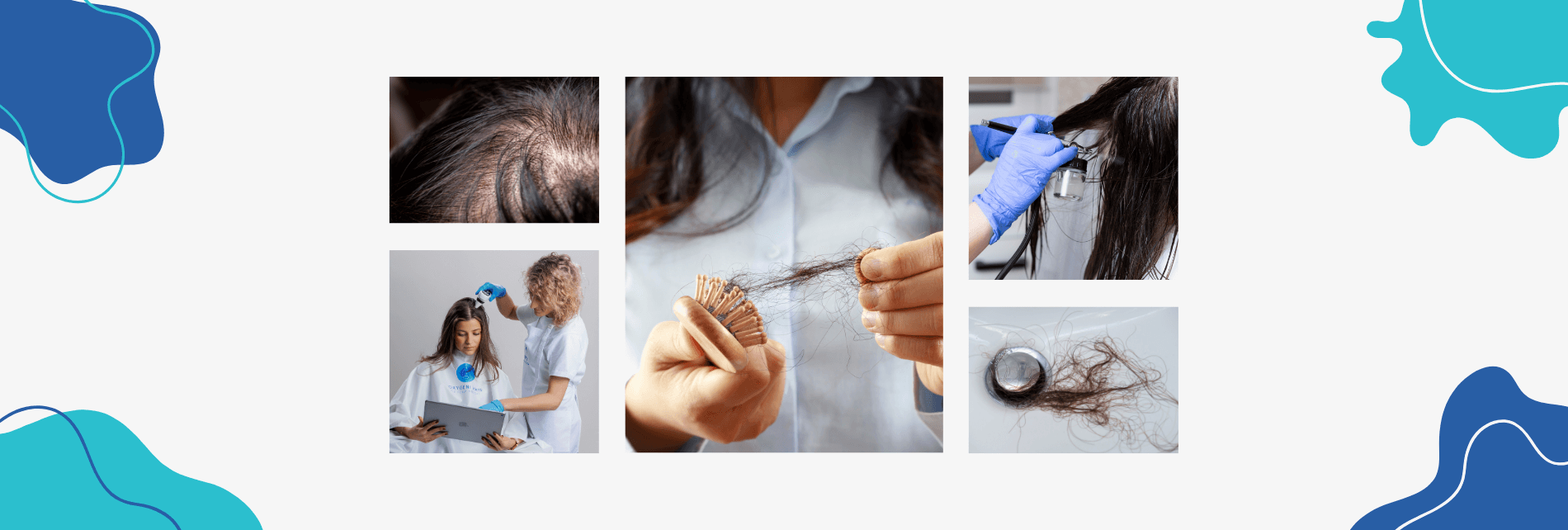
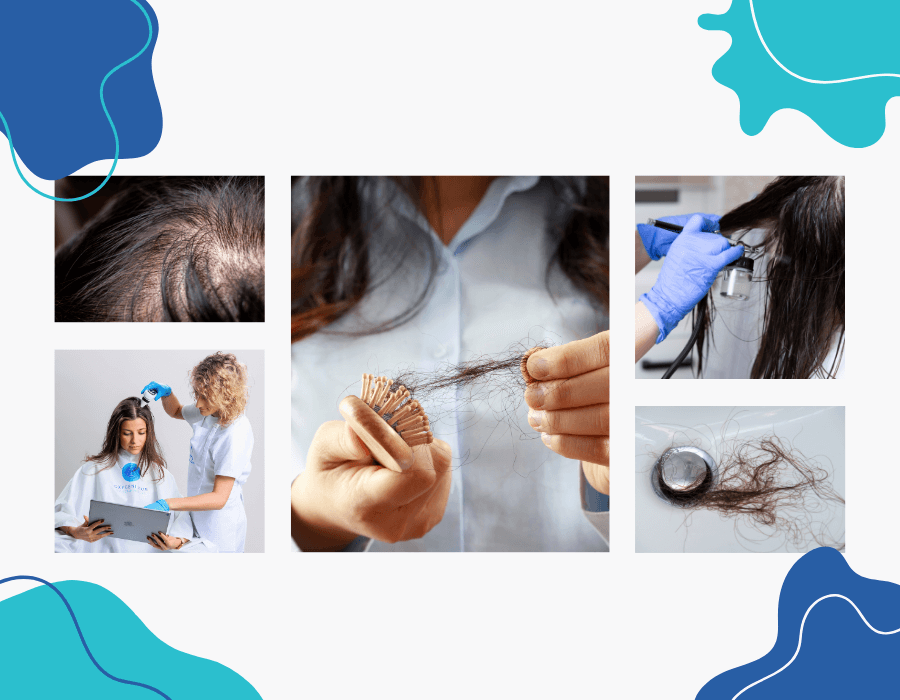
What can cause hair loss, and how can we maintain healthy hair?
Hair loss is a natural process up to a certain point, as it is part of the hair’s life cycle. Seasonal changes, especially in autumn and spring, can also trigger hair loss, which is completely normal and temporary. However, if it becomes persistent, it is essential to identify the underlying causes (which can be quite varied) and seek targeted solutions. If all efforts fail and the problem continues, it is advisable to consult a specialist, as early detection can significantly contribute to successful treatment.
To better understand the mechanism of hair loss, it’s important to know how our hair strands are structured and what they are made of.
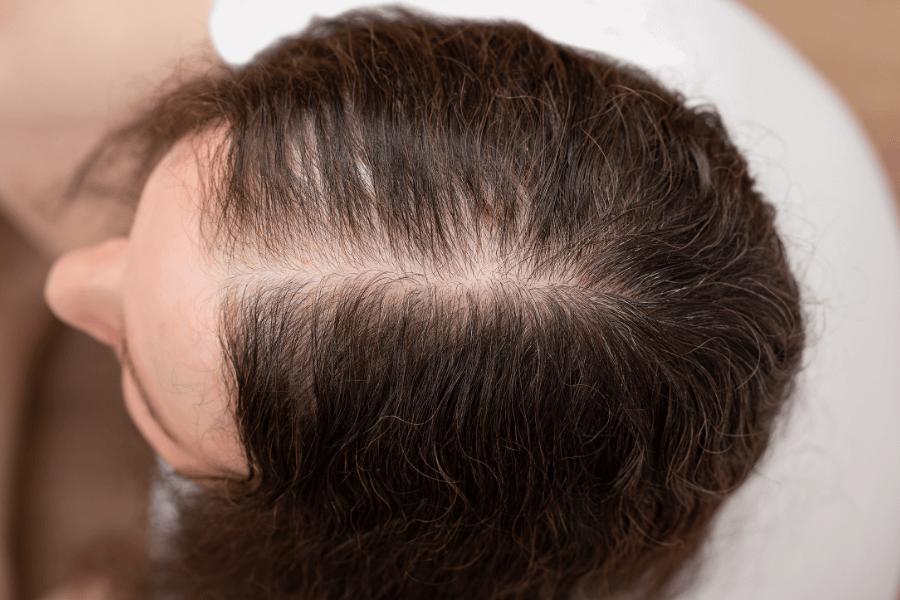
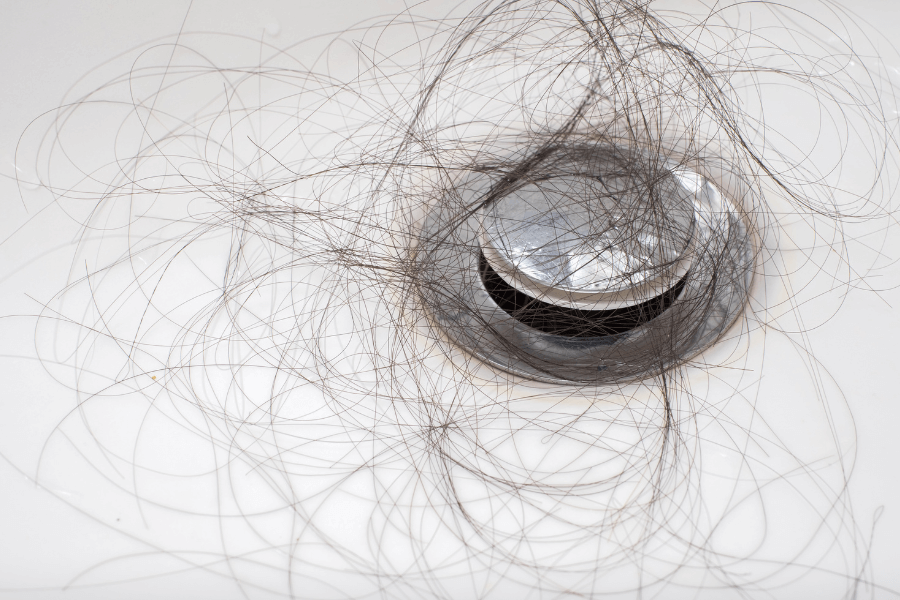
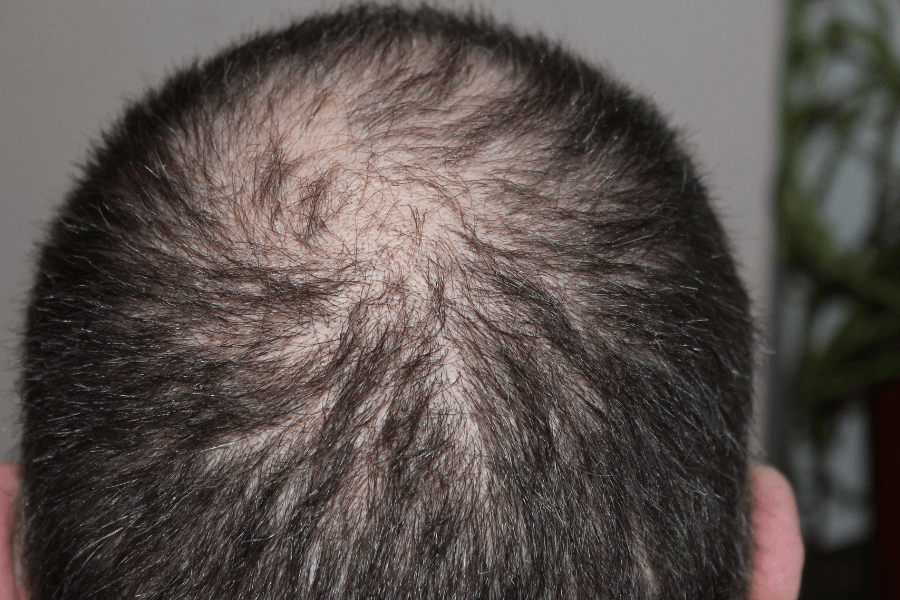
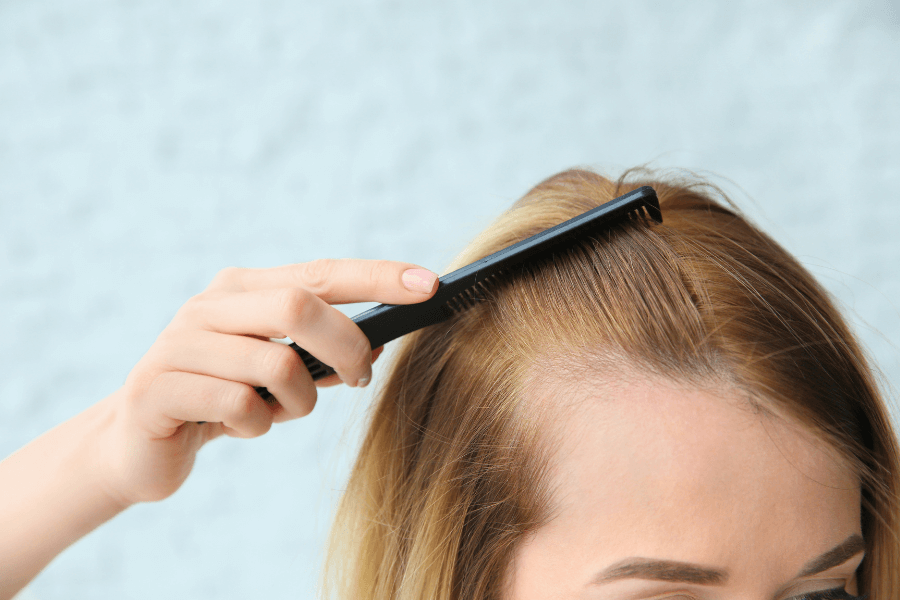
The Structure of a Hair Strand
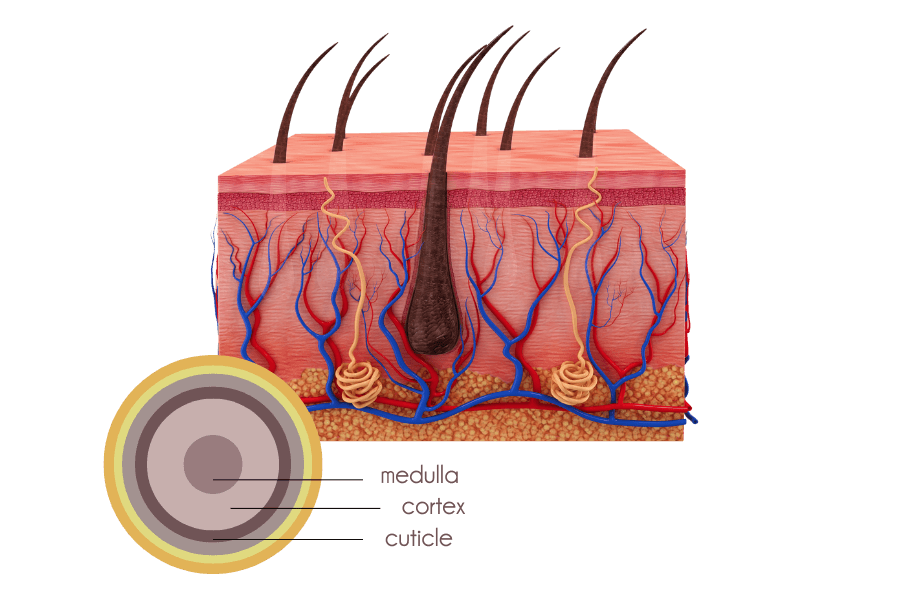
A hair strand is made up of three main layers: the innermost medulla, the middle cortex, and the outer cuticle.
The medulla is a thin channel located in the center of the hair strand, containing pigment, or in the case of graying hair, air in place of pigment. The thickness of the medulla varies from person to person, and some hair strands may not contain a medulla at all. The thickest part of the hair strand is the middle layer, called the cortex, which contains protein bundles held together by sulfur bonds. The outer layer, the cuticle, consists of cells arranged like roof tiles, protecting the hair from external influences (for example, the cuticle cells absorb ultraviolet rays).
On average, adults have 100,000 to 150,000 hair follicles on their heads, with a density of 250-300 follicles per cm². This density gradually decreases with age. Hair density is also linked to hair color: redheads typically have 80,000-90,000 strands, brunettes around 100,000, while blondes have an average of 150,000. Each follicle can grow 20-30 new hairs during a lifetime. Hair grows at a rate of 1-1.5 cm per month, with faster growth in summer than in winter.
Role of the Hair Follicle
A hair follicle is a small, sack-like structure with its own rich blood supply (its shape gives it its Latin name folliculus, meaning “skin sack” or “pouch”), from which a hair strand grows. The thickness of the hair strand depends on the size of the follicle opening.
The most crucial area for hair production lies deep within the follicle in the hair bulb, where a group of rapidly dividing cells, known as the matrix is found. As these matrix cells divide, they push upward and gradually transform into the various layers of the hair strand. In everyday language, the “hair root” refers to the combined structure of the hair follicle and hair bulb.
Life Cycle of hair
The life cycle of hair depends on the activity of the hair follicles, which consists of three phases: the growth (anagen), transition (catagen), and resting (telogen) phases.
During the active, or anagen phase, the matrix cells are continuously dividing, allowing the hair to grow about one-third of a millimeter each day. This period is the longest in the hair’s life cycle, lasting an average of three years. At any given time, around 90-95% of our hair is in this growth phase.
Next is the transitional phase, the catagen phase, which lasts 2-4 weeks. In this phase, cell division stops, and the hair strand detaches from the papilla, beginning to push outward in the follicle.
The hair then enters the resting, or telogen phase, which lasts between 3-4 months. During this phase, the hair strand is only held in place by the follicle’s outer layer. Meanwhile, cell division resumes deep in the follicle, and the growth of a new hair strand begins. As the new hair grows, the old hair strand in the telogen phase falls out, making room for the new hair. Approximately 5-10% of hair is in the resting phase at any given time. Based on this, losing around 100 hairs a day is considered normal.
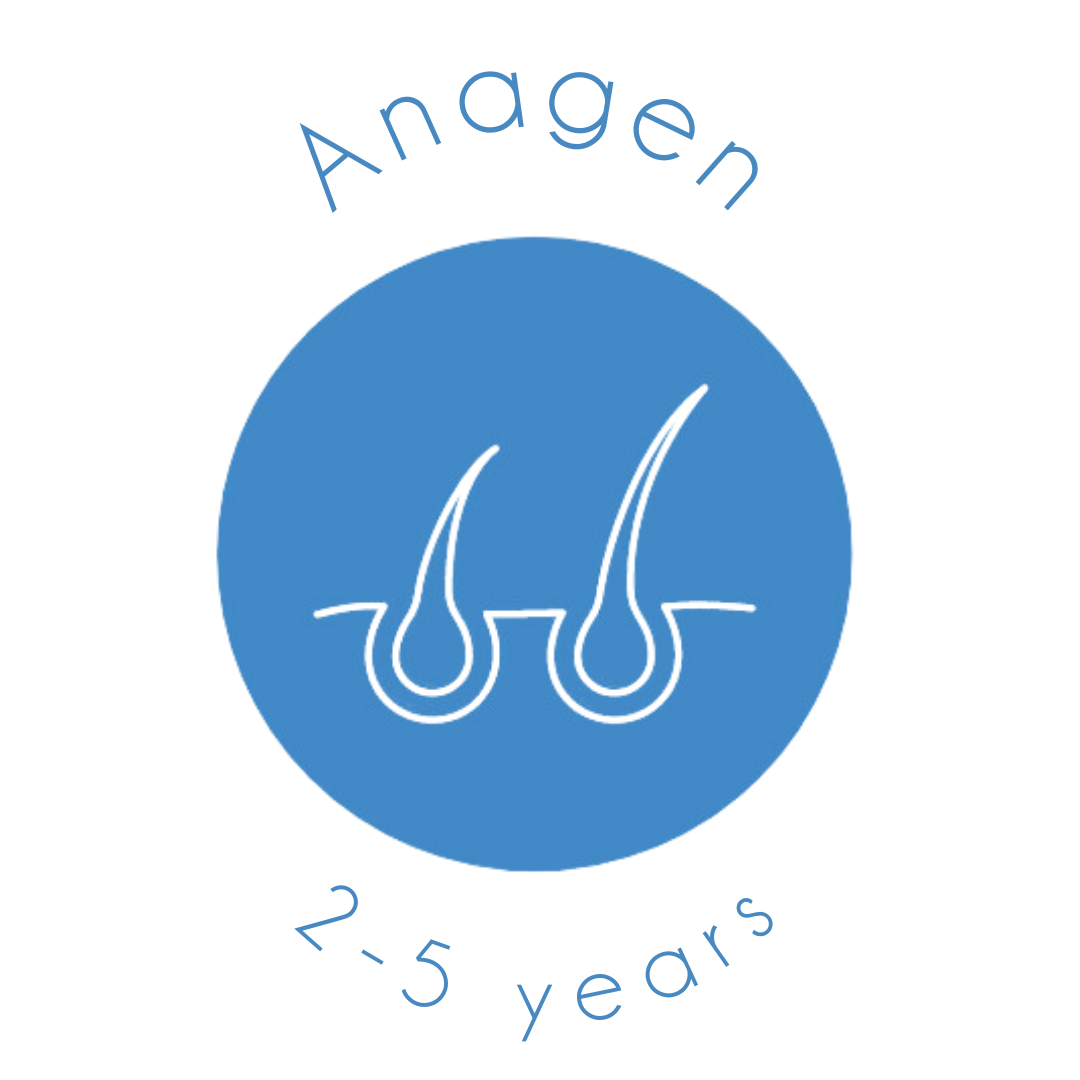
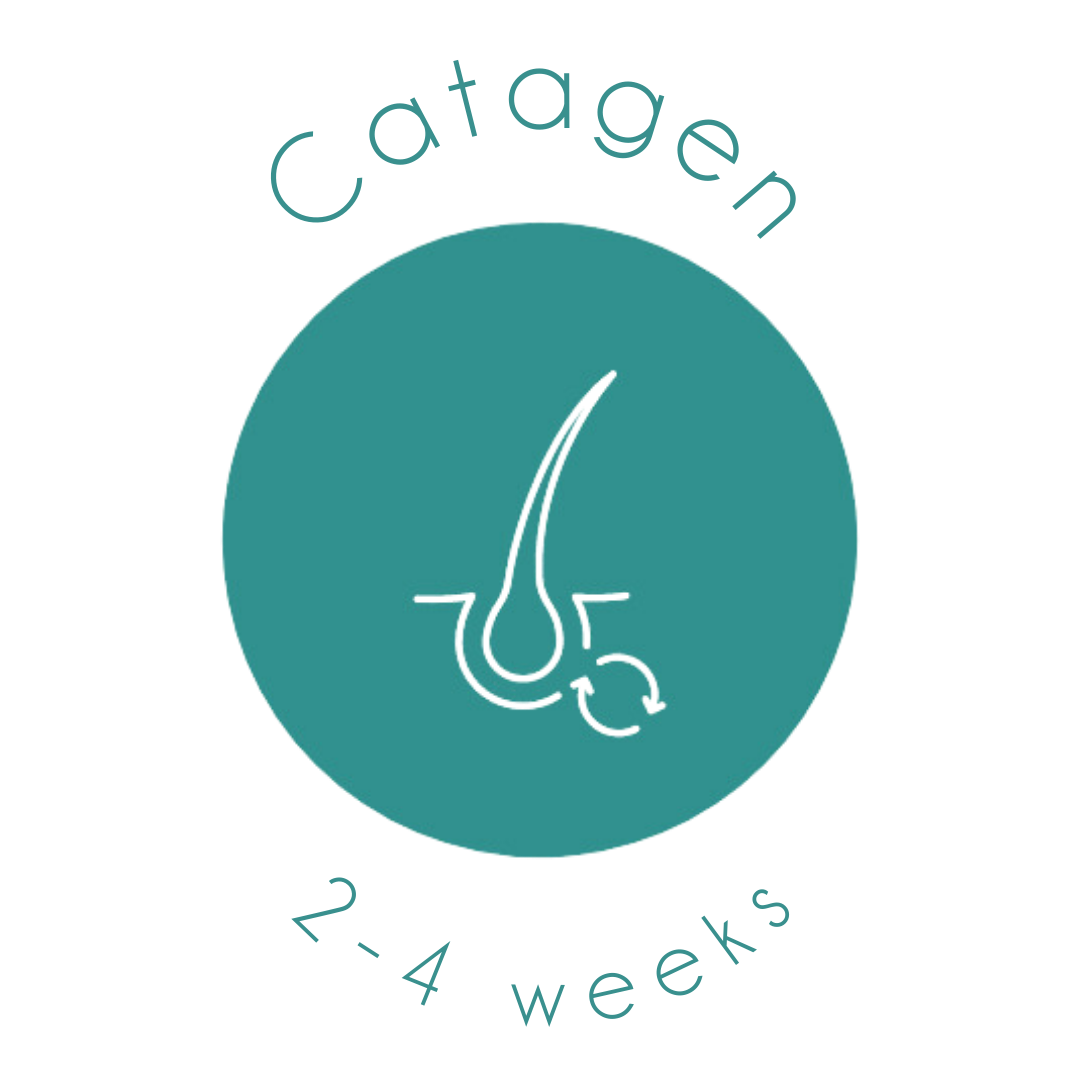
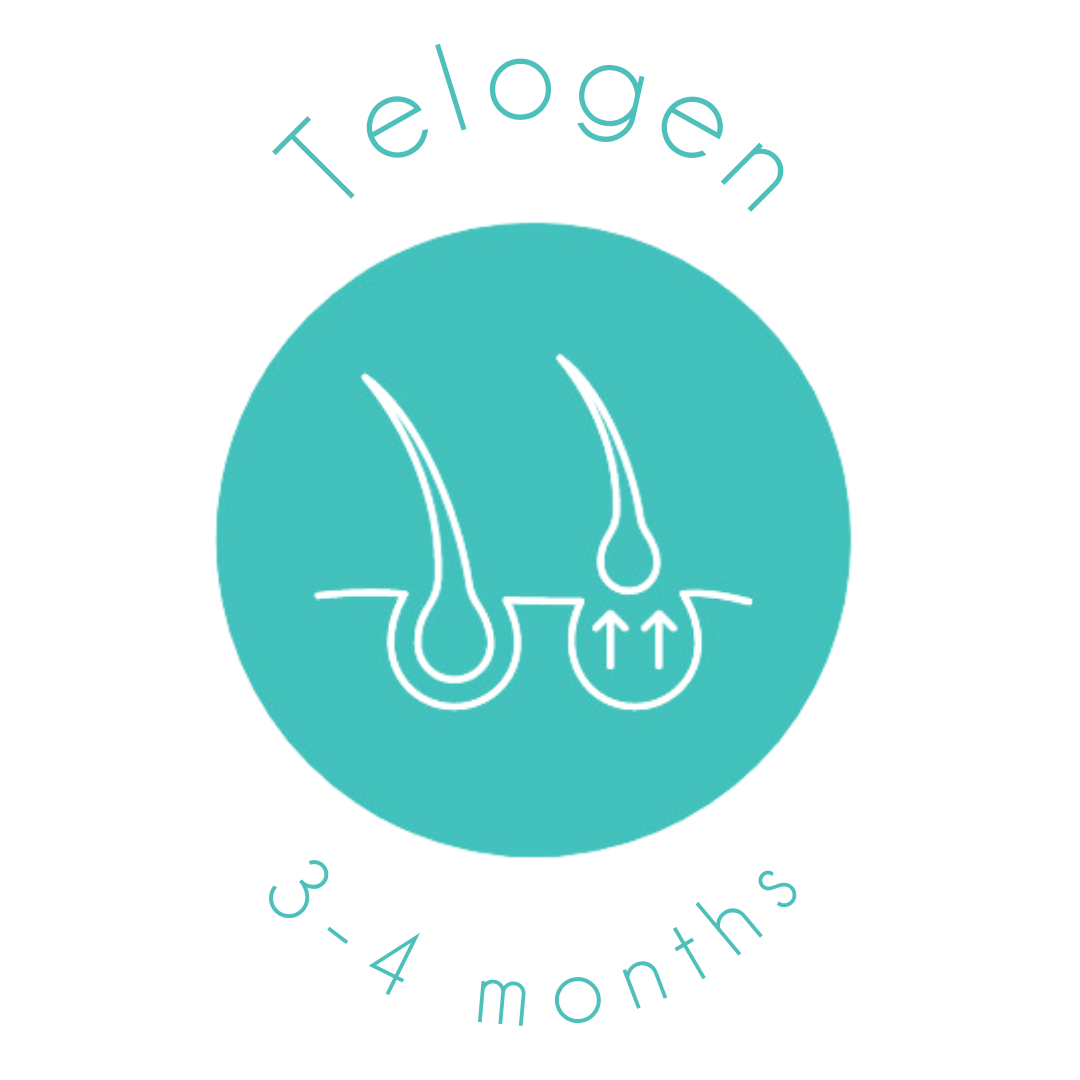
What Does Healthy Hair Look Like?
Just as our skin quality varies, hair types differ as well. Those with fine, silky hair often dream of big, voluminous locks, but this is typically only possible for those with thicker hair strands. However, healthy hair shares a few common traits: it is clean, shiny, and glossy, with ends that are not split or damaged, and a scalp that is free from dandruff. Our hair serves more than just a decorative purpose; it also plays a protective role. A clear example of this is the increased occurrence of sun-induced skin cancers and keratin abnormalities on bald scalps.
Hair is also one of the best indicators of our overall health. Conditions like anemia or high stress levels can cause hair and nails to become dull, and brittle, or even lead to hair loss. Hair strands are made up of proteins and minerals, and once damaged, they cannot regenerate. The formation of healthy hair requires a variety of amino acids (the most important being sulfur-containing cysteine) and minerals.
The Mechanism of Hair Loss
The process might seem complex at first, but understanding the potential mechanisms of hair loss is crucial for deeper insights. Let’s explore how the rapidly dividing matrix cells (mother cells) responsible for hair production in the follicle react to various factors:
1. The anagen (growth) phase ends earlier than expected (see the hair cycle), transitioning into the telogen (resting) phase, followed by hair loss.
2. Another possibility is that the division of matrix cells in the anagen phase temporarily slows down or stops.
ABNORMAL OR PATHOLOGICAL HAIR LOSS
Hair and scalp disorders occur more frequently in everyday medical practice than one might think. Moreover, hair loss can often be both a cause and a symptom of other diseases. Any alteration affecting the hair and scalp changes the patient’s external appearance, thereby impacting their self-image, which can lead to significant anxiety and confidence issues. On the other hand, hair loss can also be an early sign of serious illnesses.
The Causes of Hair Loss Can Be Diverse
The causes of hair loss can be traced to numerous factors, including genetic predisposition, hormonal changes, stressful lifestyles, and poor nutrition. Additionally, environmental influences and certain diseases can contribute to hair loss, such as environmental pollutants, chemical treatments (hair dyes, chemicals), and inadequate hair care routines. Environmental hazards can damage the scalp. Harmful substances found in polluted air (smog, UV radiation, air conditioning systems) and water can weaken hair strands.
What Types of Hair Loss Are There?
Diffuse Alopecia (hair loss not limited to a specific area)
This category includes several conditions characterized by telogen hair loss of various origins. Visible hair loss affects the entire scalp, and the speed of its development mainly depends on the number of hairs reaching the telogen phase and subsequently falling out. Typically, there is no redness, scaling, itching, or skin atrophy of the scalp.
– Postpartum diffuse hair loss
– Changes in thyroid hormone levels
– Hair loss due to weight loss
– Hair loss caused by iron deficiency
– Hair loss due to zinc deficiency
– Hair loss due to fever
– Hair loss associated with systemic diseases
– Hair loss caused by emotional stress
– Others: hair loss due to surgeries, medications (such as allopurinol, ACE inhibitors, heparin, beta-blockers, oral contraceptives, psychotropic drugs, etc.), and hair loss due to menstruation
Typically, treating the underlying problem normalizes hair loss as well. Spontaneous hair regrowth is generally observed within six months after the triggering factor has ceased. Besides oxygen therapy, specific treatment is usually not required.
Spot Baldness (Alopecia Areata)
This condition is very common, usually occurring in young adults and often in children, affecting all genders equally. In most cases, it primarily impacts the scalp but can also develop in other hairy areas, such as the beard area. Typically, one or more round or oval bald patches are visible, and the skin shows no reaction (mild redness may occur), along with signs of skin atrophy.
Ophiasis: This type begins at the nape of the neck and temples, with some hairs remaining. There may be subsequent hair regrowth.
Total Alopecia Areata: The localized bald patches merge, resulting in complete hair loss. Often, there is no subsequent hair regrowth.
Universal Alopecia Areata: Simultaneous loss of all body hair occurs (including eyebrows, eyelashes, and body hair). Full hair regrowth is rare.
Hair loss in newborns
Before birth, almost all of a fetus’s hair is in the telogen stage, which is why hair typically falls out at the end of this phase—around 6 to 8 weeks after birth. Gradual hair growth usually resumes over the following months. By the end of the first year of life, the hair starts to develop according to its own cycle.
Hair loss caused by infections
In cases of fungal infections, it is not always possible to determine the specific fungus causing the symptoms based on the clinical picture alone, as they can often appear very similar. In such cases, using a Wood’s lamp or examining microbiological culture can be helpful.
Microsporia capitis (superficial fungal infection), superficial fungal infections (primarily in children), deep fungal infections (involving deep infiltration and pus formation), and tinea capitis (very rare, spreads from person to person).
Alopecia Syphilitica (syphilitic hair loss)
As mentioned earlier, syphilis is becoming increasingly common. Among the many symptoms that this sexually transmitted disease can produce, some affect the scalp. Hair loss in stage II of syphilis occurs due to toxins released from pathogens found in small elevations on the scalp. Two forms are known: one is Alopecia syphilitica parvimaculata (primarily in an irregular shape over the nape of the neck), and the other is Alopecia syphilitica diffusa (similar to telogen effluvium).
Anagen hair loss
In this case, the damaged hair shaft breaks off and falls out after leaving the hair follicle. In the vast majority of cases, this occurs due to chemotherapy, poisoning, or drug side effects (such as thallium, and colchicine), but it can also occur due to radiation exposure. Anagen hair loss is generally stoppable and reversible; however, in cases of significant toxic damage, if the hair follicles die, hair regrowth cannot be expected.
Hair loss due to physical damage or chemicals
Inflammation caused by modern hairdressing chemicals (permanent waves, dyes) and physical injuries from tools (such as sharp-toothed or metal combs, overly dense combs, hair dryers, etc.) can also cause hair loss. Hair strands exposed to long periods of stress wear out. The hair strands break at the affected areas, which can clinically present as focal and diffuse alopecia. When wet, hair is prone to tangling, and in the case of long hair, to matting (which is caused by the breakage of tangled hair during washing). This process is often irreversible, and the hair may need to be cut.
Trichotillomania
This condition is psychologically motivated, primarily requiring psychiatric treatment. It occurs more frequently in children and women. It is characterized by localized hair loss in areas of the forehead and temples that are more easily reached by hand, due to twisting, rubbing, and pulling out of hair strands. The hair follicles remain intact, and punctate bleeding can often be observed at their openings due to the pulling out of anagen hair strands.
Traction alopecia
This condition occurs due to the prolonged wearing of a very tight ponytail or bun, leading to hair thinning and hair loss along the hairline. If the hair is subjected to this effect for too long, the process can become irreversible.
Alopecia caused by hair shaft abnormalities
Congenital, hereditary hair shaft abnormalities are very rare and can cause hair loss through hair breakage. There is no effective treatment for these conditions (except for acquired cases of trichorrhexis nodosa).
Alopecia occurring alongside autoimmune skin diseases
Autoimmune diseases refer to conditions in which the body mistakenly recognizes its own tissues and cells as foreign and produces antibodies against them. The most common type of focal, scarring alopecia occurs alongside discoid lupus erythematosus, resulting in vivid red, spreading patches with central scarring.
Folliculitis Decalvans
This disease is presumably a result of the body’s abnormal response to common bacteria. It is more common in adulthood. The chronic process accompanied by pus formation leads to scarring. It can also appear in other hairy areas of the body. Typically, small, atrophic, inflamed pus-filled nodules surrounded by bald patches develop on the top of the head.
Pseudopelade Brocq
This is an unknown-origin disease that primarily occurs in middle-aged women. In the early stages, a pale reddening of the skin may be visible. Hair loss begins in small patches, the skin shrinks, and as the process progresses, the patches can merge. Its characteristic appearance on the scalp resembles “footprints in the snow.” Complete hair loss generally does not occur.
Scleroderma Lineare
This condition involves localized thickening of subcutaneous connective tissue following inflammation, leading to atrophy. The affected area forms in the midline of the scalp, running longitudinally across the top of the head, resembling a “sword cut scar”. It causes permanent hair loss.
Alopecia Mucinosa (mucinous folliculitis)
Small elevations on the hair follicles form on the scalp, which can combine to create larger, infiltrated areas that exhibit hair loss on their surface. It can also occur on other parts of the body. One form typically affects the younger population and arises in small, circumscribed areas. Another form is associated with various lymphatic tumors and can appear throughout the body. In this case, the underlying disease must be treated primarily.
Alopecia occurring alongside malignant tumors
In contrast to alopecia areata, alopecia in this context may manifest as one or more areas with a slightly denser texture, a smooth surface, and occasionally a slightly retracted surface. This typically occurs in women with breast carcinoma and men with lung tumors.
What Does a Trichologist Examine in Cases of Hair Loss?
To assess the extent of hair loss, the entire scalp must be examined. By gently parting the hair, we can easily determine hair density and identify any abnormalities that may contribute to hair loss. It’s important to note that there are ten times more bacteria on the surface of hair strands than on the surrounding skin!
In cases of hair loss, the trichologist must examine which types of hair are falling out the most. The simplest method is to gently tug on the hair strands and inspect their ends. In most cases, we can obtain bulbous-ended hairs that are in the telogen phase (the resting phase following the growth and transitional periods), but we may also find split ends and hairs in the anagen phase, which can help lead us closer to a diagnosis.
In cases of telogen hair loss, the amount of hair that remains in our hands is typically three to four times the normal amount. (Normal average hair loss is less than 100 strands per day.) We may observe split ends, known as “exclamation mark” hairs, particularly at the edges of patches in conditions like alopecia areata.
With cosmetic damage (such as perming or dyeing), split ends can break off when gently tugged at the base. In anagen hair loss, the hair ends are elongated and moist. Healthy anagen hairs can only be pulled out with significant force, which naturally causes pain. The quantity of hair left in hand also depends on how recently the patient has brushed or washed their hair.
A common examination method involves asking the patient to collect lost hairs in separate plastic bags over the course of a week, gathering them from their comb, pillow, shower, sink, and clothes, then counting them and averaging the amount lost over the seven days. This method allows for an objective assessment of subjective complaints.
Less frequently, a histological examination of the scalp is performed (only when necessary), which can determine the telogen/anagen ratio, examine hair follicle structure, and in some cases—primarily in scarring alopecias—provide insights into the cause of hair loss. Skin sampling can only be conducted by a medical professional!
Chemicals Causing Hair and Scalp Problems
Why is it essential to strive for a chemical-free home and use products without harmful substances? Many illnesses and skin conditions are undeniably linked to the chemicals that surround us in our daily lives.
SLS and SLES
Sodium Lauryl Sulfate (SLS) is a harsh agent that strips hair of essential oils and hinders healthy hair growth. Sulfates (SLES) create a lot of foam but clean too aggressively and can dry out the skin significantly.
Parabens
Parabens affect hormonal balance and studies suggest they may increase the risk of cancer. It’s important not to be misled by the “paraben-free” label on shampoos. Just because a product is paraben-free doesn’t mean it’s free from harmful chemicals.
Polymers (Plastics)
While they provide a silky softness and nourished feel, this effect is merely superficial. The production of these chemicals involves toxic processes that release harmful gases, detrimental to both the planet and human health.
Synthetic Fragrances
These components can cause severe irritation and allergic reactions. In 100% natural products, the term “fragrance” refers exclusively to natural scent compounds.
Silicones
Silicone layers prevent essential nutrients and moisture from penetrating the hair, making the hair heavy and weak over time. Most silicones take hundreds of years to decompose in nature.
Petroleum Derivatives
At first glance, these may seem like good moisturizers, but they should be avoided for several reasons: they prevent water from evaporating from the skin, which can be very unhealthy in the long run. They also contribute significantly to environmental pollution.
Preservatives
Ingredients such as alcohol, parabens, EDTA, or formaldehyde can irritate the skin over time and pollute the environment. They may also be potential carcinogens and disrupt hormonal balance.
Aluminum Compounds (ACH)
Primarily found in deodorants for their antiperspirant properties, aluminum is a highly irritating substance. Instead, opt for products enriched with natural fragrances such as essential oils, hydrosols, and plant extracts.
Other harmful chemicals:
Synthetic colorants
Palm oil
Polyethylene glycol / PEG, Polyethylene / Polyoxyethylene
Sodium Chloride
Improper hair care habits
Beyond avoiding chemicals, there are additional factors to consider to prevent hair loss and damage.
Hot water can dry out the scalp and weaken hair strands, leading to hair loss. Therefore, avoid washing your hair with water that is too hot; lukewarm water is optimal. Excessive hair washing and using unsuitable shampoos can both contribute to the development and worsening of hair loss.
Excessive heat from frequent use of hair dryers, straighteners, and curling irons can damage hair, making it dry and brittle. Always use a heat-protectant spray to protect your hair.
Tightly worn hairstyles, such as tight ponytails and braids, can break hair strands and weaken the hair, potentially leading to hair loss. Reduce tightly secured hairstyles and wear your hair down more often. If you must tie your hair up, choose looser styles.
Do not go to bed with wet hair! Hair dries more slowly under these conditions, creating an ideal environment for bacteria and fungi. This can cause various scalp issues and lead to itching and flaking. Additionally, wet hair is most vulnerable, so turning in bed with wet hair can easily lead to breakage.
Choose loose hairstyles for sleeping that protect your hair from breakage and tangling. Examples include a loose braid or a high, loose bun. Use silk hair ties, silk or satin hair wraps, or sleeping caps. Ideally, the pillowcase should also be made of silk, as this prevents hair tangling and reduces friction with the pillow. Silk material does not damage hair strands and has antimicrobial properties.
Selecting the right comb and mastering proper brushing techniques also play an important role in maintaining hair health and appearance. Choose a fine-toothed comb appropriate for your hair type and avoid combs and brushes with small balls on the tips of the comb. The correct brushing technique involves starting from the bottom and working up in small sections with gentle movements. Avoid pulling on the hair; if you encounter a knot, gently unravel it with your fingers, never tugging with the comb. Progress gradually in smaller sections. If it is difficult to comb through the hair, use a detangling spray that helps condition the hair and makes it easier to comb out. Regularly clean and wash your comb or brush, removing hair strands and product residue.
Tips for your haircare routine to promote healthy hair growth
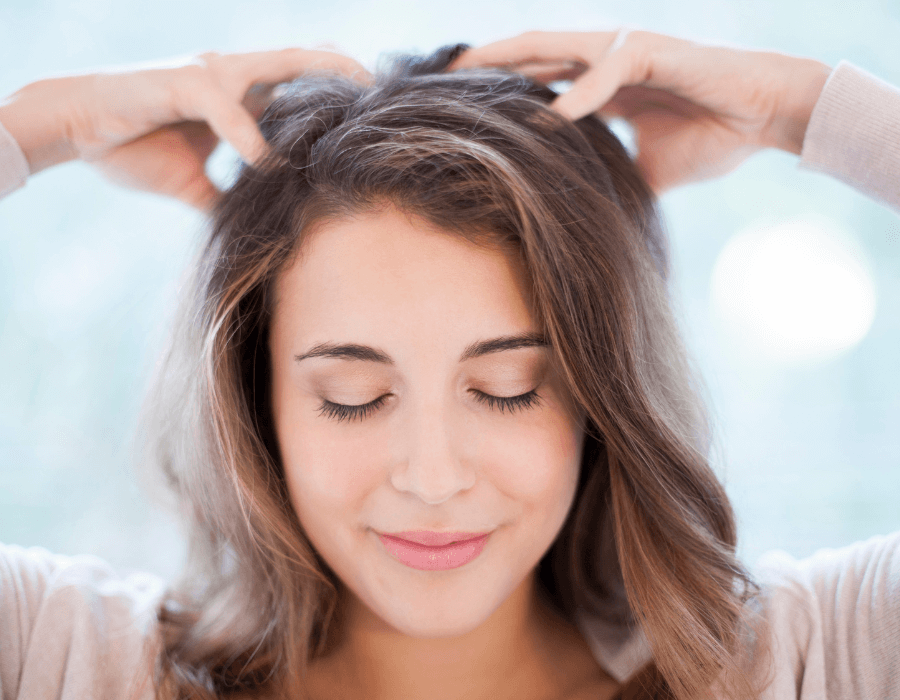
Scalp massage
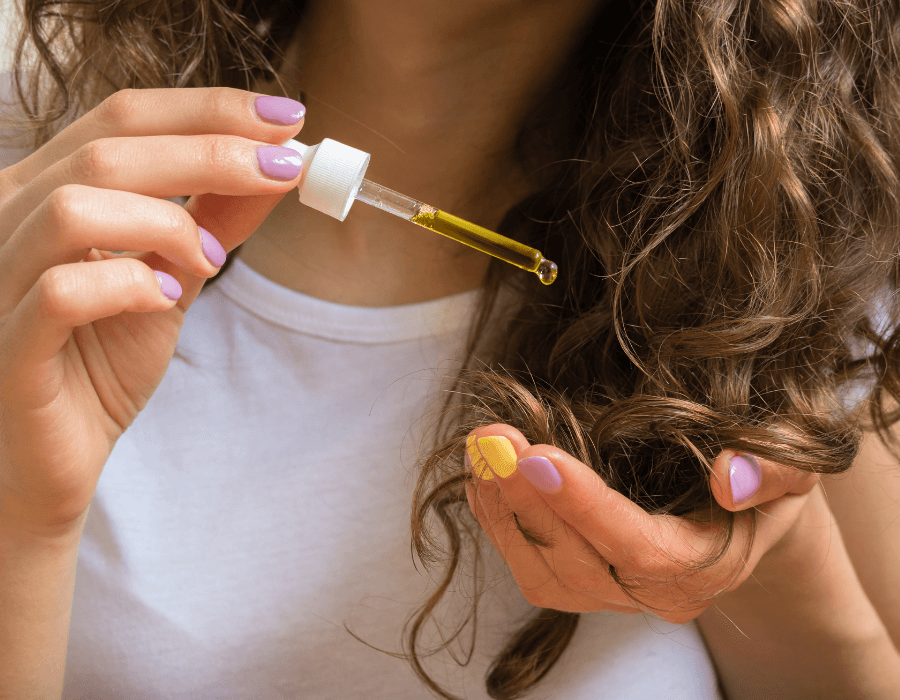
Hair end care
Hair Loss Treatment
Nutrient rich diet
Proper nutrition is essential for the health of the body and hair. Certain foods can contribute to the worsening of hair loss, while others can help prevent it. Hair follicles require nutrients for growth and regeneration.
Foods and beverages high in sugar should be avoided, as they can cause inflammation in the body. Processed foods and high-fat fast foods do not provide enough nutrients and may contain unhealthy additives. Additionally, excessive caffeine can disrupt the body’s hormonal balance, which negatively impacts health and is reflected in the hair.
Instead, consume fresh vegetables and fruits, whole grains such as oats, and protein-rich foods. Hair is primarily made of keratin, which is a protein, therefore, protein-rich foods are extremely important. Consuming the right amount of protein is essential for hair growth. The best protein sources include meats, fish, eggs, and legumes.
Proper hydration is also crucial for hair health and growth. Dry hair is more prone to breakage, making it difficult to achieve longer hair. It’s important to meet the daily recommended water intake, as it helps the body eliminate toxins and supports cell health, including that of hair follicles.
Sleep and Rest
Getting the right amount of sleep and rest significantly contributes to hair growth and the body’s essential regeneration processes. During sleep, the body regenerates, and hair is no exception. Restful sleep can help maintain the health of hair follicles and promote hair growth. Insufficient sleep can lead to stress, which can cause hair loss.
Vitamins and Minerals
Many vitamins and minerals can help support hair growth. Biotin and collagen are particularly popular among vitamins. Always consult your doctor before starting any dietary supplements to ensure they are safe and appropriate for you.
Vitamin A:
Vitamin A is a fat-soluble vitamin that contributes to healthy vision and the proper functioning of the skin and hair. However, excessive consumption is not recommended, as it can cause liver damage and lead to dry skin and hair loss. The daily required intake is 4,000 IU (international units). Natural sources of vitamin A include fish, egg yolks, and orange, yellow, and red vegetables and fruits.
B Vitamins:
B vitamins are water-soluble vitamins, with B7 (biotin) being the most important for hair and nail health. Natural sources of biotin include rice, nuts, legumes, and cauliflower.
Vitamin C:
Vitamin C is also a water-soluble, antioxidant vitamin. Its main benefits include strengthening the walls of capillaries in the skin layer. The recommended daily dose is 40 milligrams, which should be maintained to prevent hair loss.
Vitamin E:
Vitamin E is a fat-soluble antioxidant that contributes to the health of hair and nails. It is found in oily seeds, olive oil, and wheat germ.
Folic Acid:
Folic acid is a water-soluble vitamin essential for hair, as it aids in cell division, making it crucial for the health of hair follicles and healthy hair growth. The daily amount is approximately 400 micrograms. Folic acid can be found in whole grains and legumes.
Zinc:
Zinc is an essential mineral needed by every cell in the body. It helps maintain healthy hair and skin and balances hormonal levels. The daily requirement is about 10-12 milligrams. Natural sources include meats, eggs, dairy, nuts, and almonds.
Copper:
Copper is an important trace element involved in the production of melanin, the pigment that gives hair its natural color. It also plays a role in collagen synthesis, which maintains the elasticity of hair and skin. Copper is found in many foods, including rye, wheat, bananas, mushrooms, and tomatoes. It also contributes to iron absorption and utilization in the body. The daily amount is approximately 3 milligrams. Natural sources of copper include seeds, nuts, whole grains, and legumes.
Selenium:
Selenium is an antioxidant mineral essential for maintaining scalp health. It has anti-inflammatory properties, which can help reduce scalp irritation. It significantly supports the function of enzymes. It can be found in fish, eggs, and grains. If taken as a supplement, it’s important to adhere to the recommended dosage.
Iron:
Iron is one of the most important minerals in the body, as it helps supply oxygen in the blood and significantly supports immune system function. Iron deficiency can lead to fatigue and hair loss, so replenishing iron can resolve the causes of hair loss. Natural sources include beef, dried fruits, and sorrel. Low iron levels can lead to anemia, which causes hair loss. Iron-rich foods include red meat, spinach, lentils, and pumpkin seeds.
Myo-Inositol:
Myo-inositol has several properties that contribute to various aspects of health. It helps restore hormonal imbalances and has a particularly positive effect on the female reproductive system. It may improve insulin sensitivity and is beneficial in cases of PCOS. It can also positively affect mental health by influencing serotonin and dopamine hormones to function effectively, which helps reduce anxiety.
Maca:
Maca is a plant that has been used for its various health benefits for a long time. Its popularity stems from its ability to reduce the levels of the stress hormone cortisol, thereby helping alleviate stress symptoms and improving mental health. It increases energy levels and strengthens the immune system while being rich in vitamins and minerals. Maca also reduces inflammation and regulates hormonal balance.
But what can truly help is oxygen therapy!
Oxygen Therapy for Hair Loss
Oxygen therapy is an effective method for treating hair loss that focuses on strengthening the immune system and regenerating cells. During the treatment, 100% pure oxygen is introduced at high pressure into the upper layer of the scalp, specifically the basal layer and intercellular matrix. This enhances blood circulation in the scalp, allowing hair follicles to receive more nutrients and oxygen, directly contributing to hair growth and reducing hair loss.
During oxygen therapy, over 70 types of vitamins and minerals penetrate deep into the cells, stimulating cell division and supporting the regeneration of hair follicles. This not only helps stop hair loss but also strengthens the hair structure.
This method provides an effective solution for all types of hair loss! Significant improvements can be observed after just a few treatments, making the decrease of hair loss and increased growth of new hair noticeable in a very short time.
Results of Oxygen Therapy:
Hair growth is a process that requires patience and attention. While there is no single miracle solution that works for everyone, proper nutrition, a healthy lifestyle, and appropriate hair care habits together can bring significant changes. Remember that hair health starts from within, and consistency and patience are essential for achieving long-term results.
Natural Hair Care
The advantages of natural cosmetics include that they do not contain harmful chemicals that could damage the hair and scalp in the long run.
Herbs such as chamomile, aloe vera, and green tea have soothing and moisturizing effects. Rosemary oil and its extract are particularly good for reducing hair loss, as they stimulate blood circulation in the scalp, thereby promoting better nutrient supply to hair follicles and the formation of new hair strands. Its antibacterial and anti-inflammatory properties also contribute to scalp health.



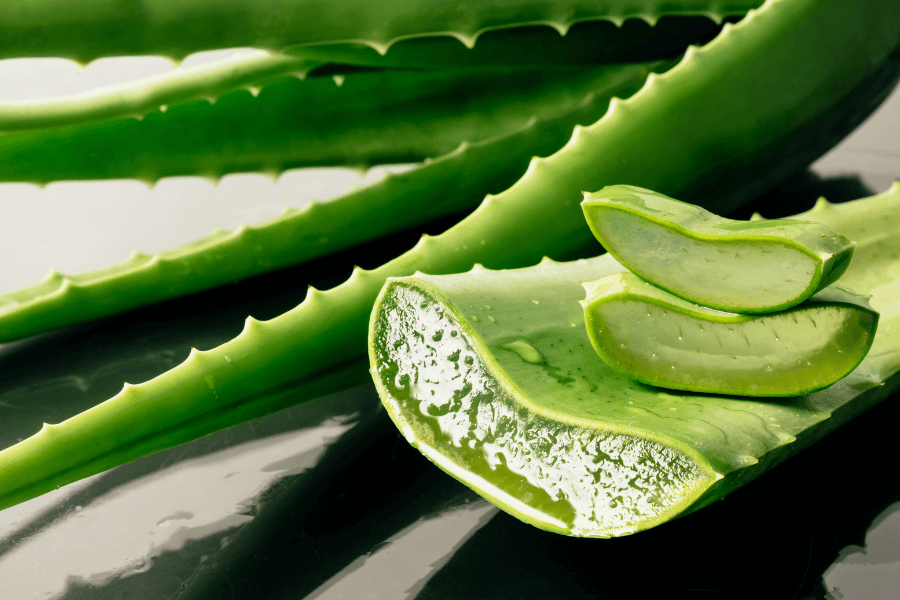
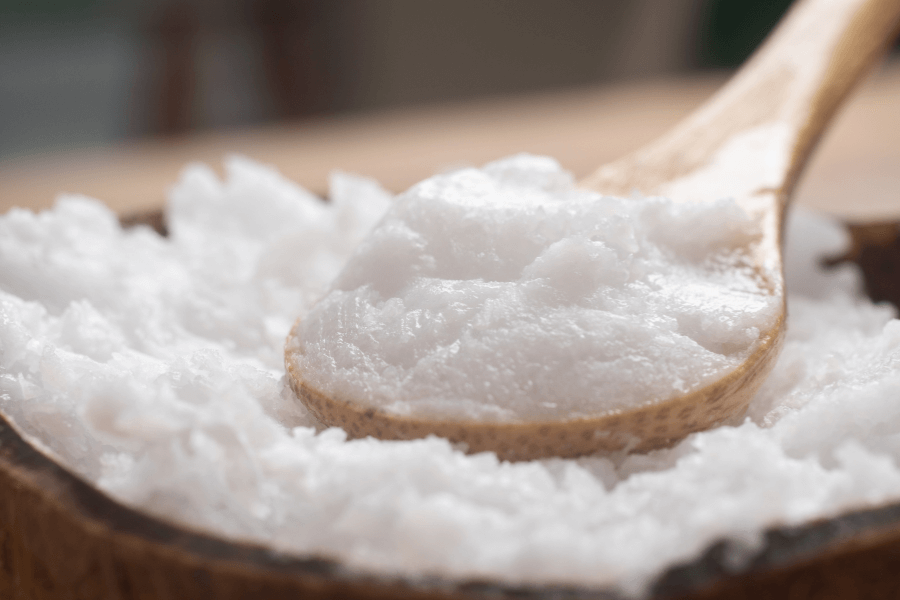
Natural ingredients for hair loss treatment:
Chamomile: Due to its soothing and anti-inflammatory properties, chamomile is particularly suitable for treating sensitive scalps. Additionally, its mild cleansing effect helps maintain the freshness and health of the scalp, reducing irritations that can lead to hair loss.
Aloe Vera: Known for its moisturizing properties in gel form, aloe vera deeply nourishes hair strands and the scalp. It also helps restore the pH balance of the scalp, which is essential for the healthy functioning of hair follicles. Aloe vera contains proteolytic enzymes that break down dead skin cells, promoting hair growth and preventing hair loss.
Green Tea: Rich in antioxidants, green tea has anti-inflammatory and hair-strengthening effects. Furthermore, certain studies suggest that green tea may inhibit the production of the hormone dihydrotestosterone (DHT), which is responsible for hair loss, thereby slowing or preventing hair loss.
Rosemary: Rosemary oil and extract are perhaps the most well-known natural solutions for hair loss. It stimulates blood circulation in the scalp, contributing to improved nutrient supply to hair follicles, thus promoting the growth of new hair strands. Rosemary also helps reduce dandruff and itchy scalp. Its antibacterial and anti-inflammatory properties contribute to maintaining scalp health, which is important for preventing hair loss.
Coconut Oil: Rich in fatty acids, coconut oil deeply hydrates the hair and scalp, helping to strengthen hair strands and prevent split ends.
Nettle: Due to its strong antioxidant content, nettle helps improve blood circulation in the scalp, supports hair follicle function, and may contribute to reducing hair loss.
Two unique ingredients against hair loss:
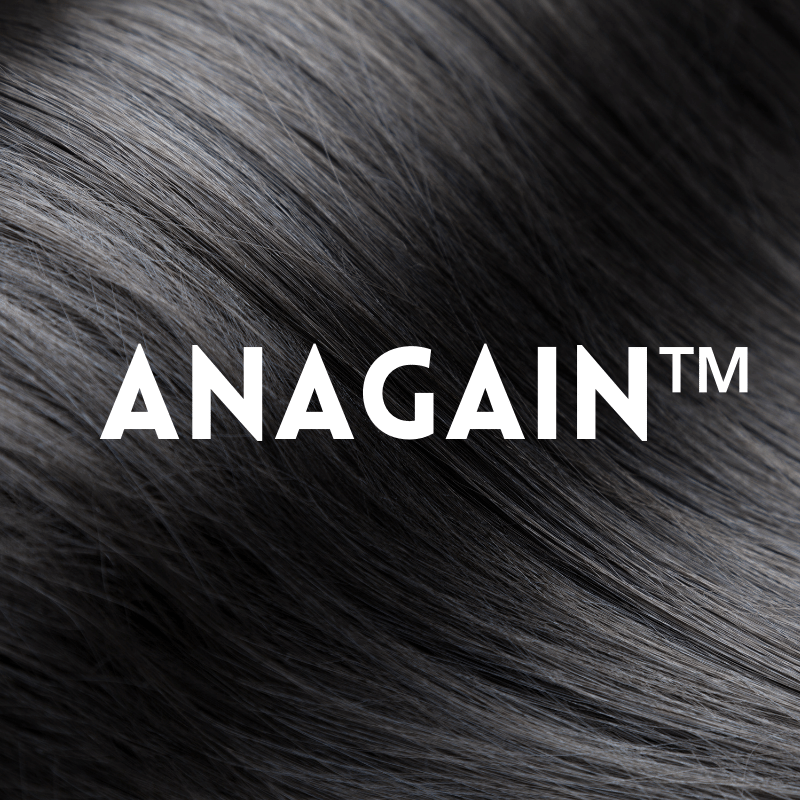
AnaGain™
AnaGain™ is a clinically proven natural and sustainable ingredient that reduces the extent of hair loss. AnaGain™ is an extract made from organic pea sprouts, rich in phytonutrients that protect the plant from various diseases and damages, positively impacting human health as well. The extract can reduce hair loss by extending the lifespan of hair strands and restoring the health and vitality of hair, as well as stimulating skin cells to restart hair growth. Additionally, it improves the quality of hair strands. Visible results can be achieved after only three months of use, with the potential to increase hair growth by 78%.
FIND OUT MORE
ABOUT ANAGAIN FROM THE VIDEO!
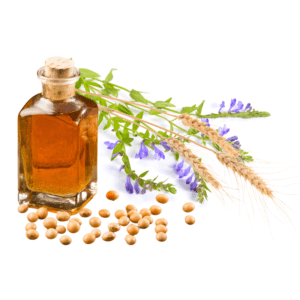
Baicapil
Baicapil is a synergistic combination of three plants that have been clinically proven to effectively combat and stop various types of hair loss with visible results. Through its innovative mechanism of action, Baicapil stimulates hair growth, increases hair density, and reduces hair loss. Hair becomes revitalized, more elastic, and healthier. It activates and stimulates hair follicles while replenishing them with valuable nutrients, leading to healthier and stronger hair strands. The combination of ingredients extends the hair growth phase and activates hair strands that are already in the telogen phase. Visible results can be achieved in just three months: hair loss can decrease by 60.6%, and hair density can increase by up to 59.3%.
FIND OUT MORE
ABOUT BAICAPIL FROM THE VIDEO!
TRY OUT OUR HAIR CARE PRODUCTS MADE OF 100% NATURAL INGREDIENTS!
For lasting hair health, using chemical-free and 100% natural products offers a long-term solution. Chemical-free products reduce intolerance symptoms while their 100% natural ingredients do not irritate the skin and scalp.. Using natural products can significantly help not only in alleviating symptoms but also in prevention!
Transform your hair care routine with our exceptional products designed specifically for hair loss! Discover the must-have additions that will rejuvenate your hair and help you achieve the healthy, vibrant locks you’ve always wanted.
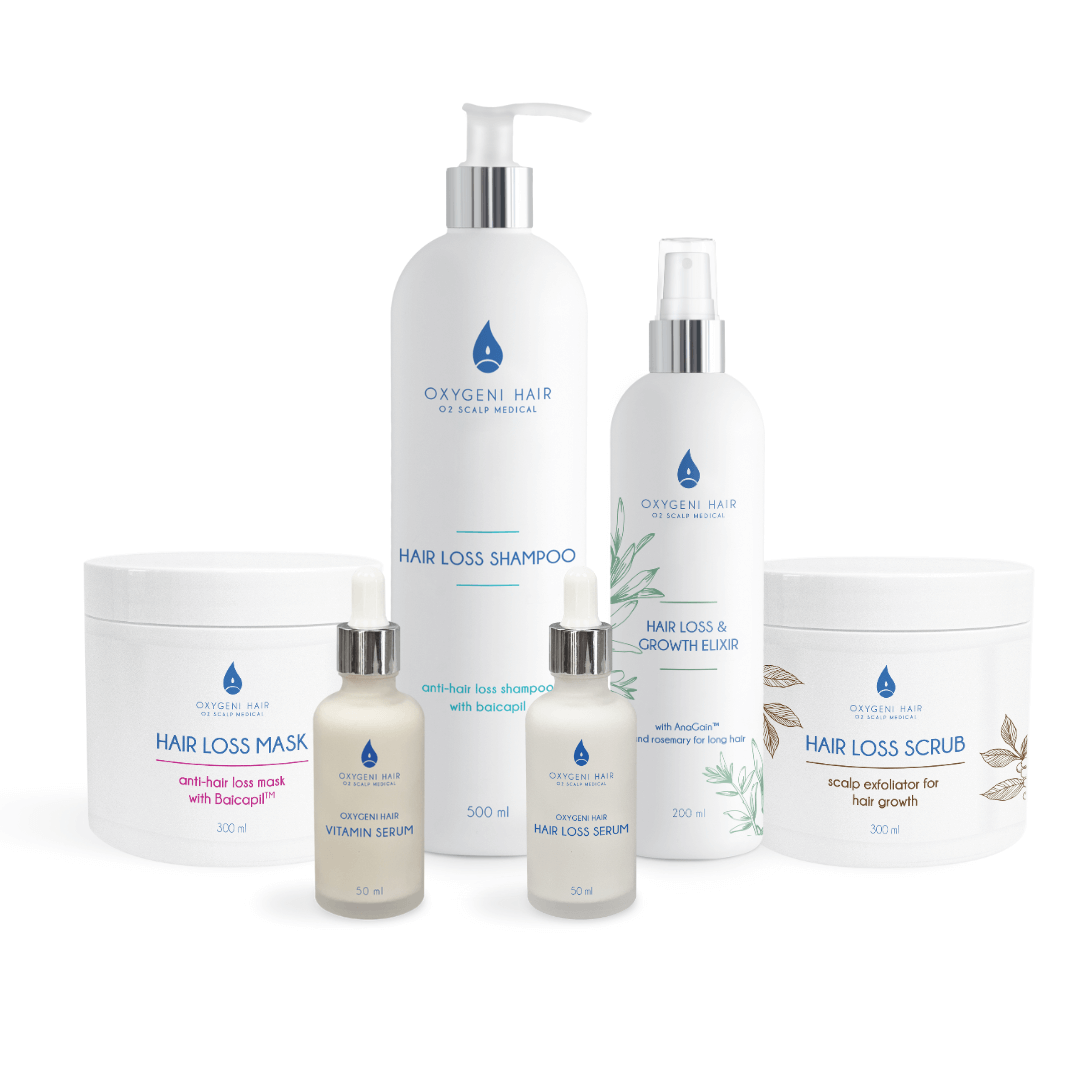
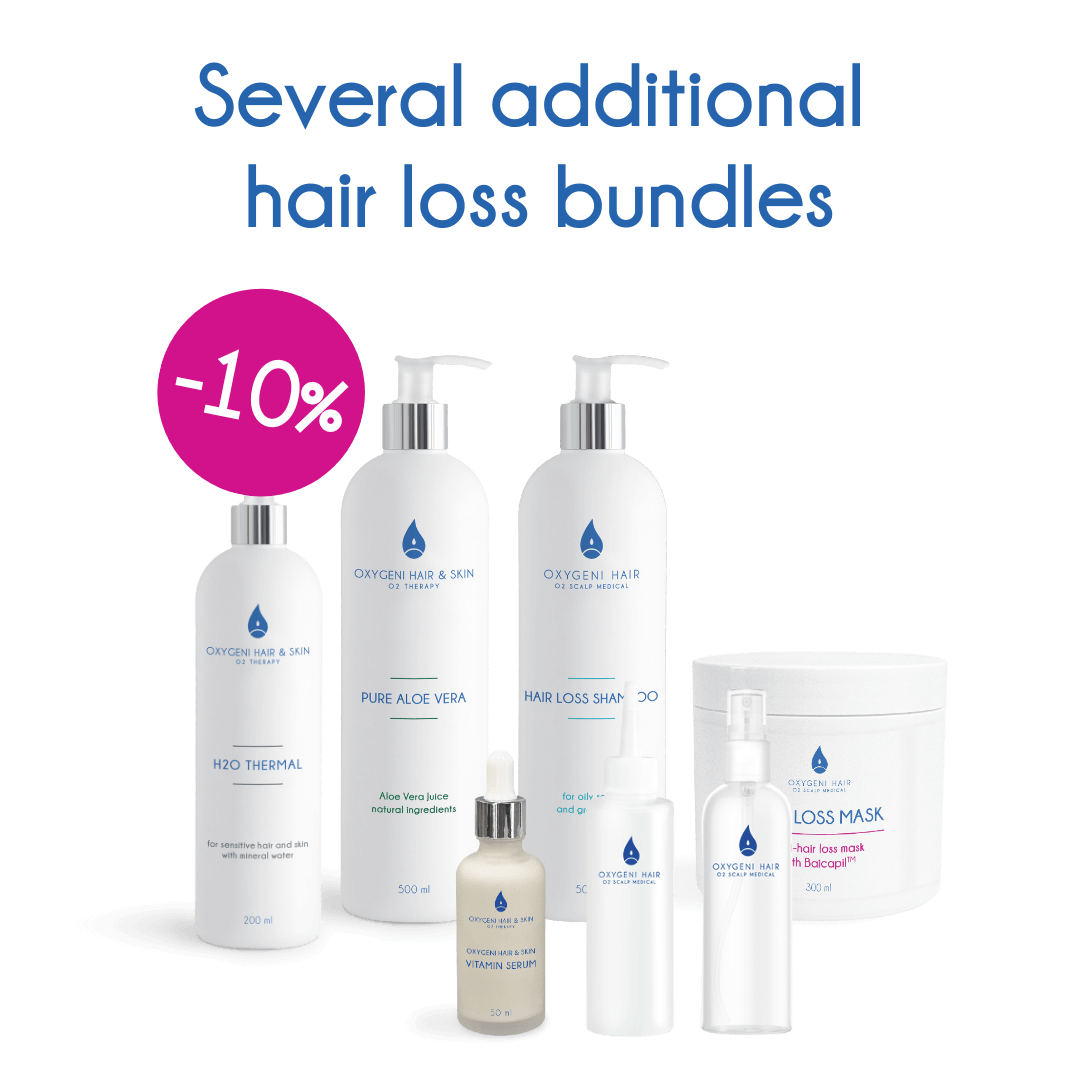
Products recommended for treating hair loss:
Discover our products that support hair growth with 100% natural ingredients! For hair loss treatment, it is recommended to purchase the products as a package!
The Hair Loss Shampoo is specifically formulated for weak and thinning hair, targeting hair loss effectively. Enriched with Baicapil and Vitamin B5, it penetrates deeply into the scalp to strengthen the hair follicles. The maca extract promotes hair growth, reduces hair loss, and improves scalp health.
This shampoo provides a solution for genetic and androgenic hair loss, diffuse or patchy hair loss, weak and thinning hair, lifeless hair strands, flat and fine hair, vitamin and mineral-deficient scalp and hair, and aging hair.
The Hair Loss Mask is a deep-conditioning treatment that combats hair loss with a rich blend of vitamins and minerals, making it the perfect complement to the Hair Loss Shampoo. It contains Baicapil, along with maca root extract, panthenol, and Vitamin B5. Together, these ingredients effectively halt hair loss, stimulate hair growth, and enhance hair density.
With a substantial amount of maca root extract, this mask revitalizes hair follicles, promoting growth and boosting resistance to external stressors, helping to prevent hair loss. Panthenol supports cellular renewal and restores damaged skin, positively affecting hair follicles by strengthening them. Argan oil’s nutrients encourage faster hair growth, while jojoba oil helps reduce hair loss, and rosemary oil fortifies hair roots and stimulates new hair growth. Linseed oil enhances hair density by stimulating growth and making hair strands more resilient.
The Hair Loss & Growth Elixir is a water-based hair growth product designed specifically to prevent hair loss and stimulate growth. Its key ingredients include rosemary extract and clinically proven AnaGain™, both known for their outstanding effectiveness in promoting hair growth. AnaGain™ is a natural active ingredient derived from green peas that has been shown to reduce shedding, improve hair structure, and extend the lifespan of hair strands, delaying their transition into the telogen phase. Users can see noticeable results in hair thickness, strength, and density within just three months.
This unique Hair Loss Scrub is 100% chemical-free and features deep-cleansing bamboo pearls that gently yet effectively remove dead skin cells and impurities. Combined with clinically proven AnaGain™ essence, it stimulates hair growth. With the Hair Loss Scrub, your scalp will be thoroughly cleansed without causing micro-scratches to the skin surface.
The Hair Loss Serum is a special 100% chemical-free product that stimulates hair growth and reduces hair loss thanks to clinically proven AnaGain™ essence. This serum rejuvenates cells, regenerates hair roots, and intensely nourishes hair follicles, preventing and reducing hair loss. It activates hair root activities and significantly speeds up the hair growth cycle while softening and making the hair easier to comb.
The Vitamin Serum is packed with the essential vitamins and minerals your hair and skin need the most. With Vitamins A, B, C, E, and antioxidants from red grapes, this hair growth serum nourishes the skin and its deeper structures, revitalizing and stimulating hair follicles and cells while strengthening the skin’s resilience and immunity.
Basic Recipe for Hair Loss Treatment and Hair Growth: Mix 20 ml of Pure Aloe Vera product with one pipette of serum in a spray bottle and apply it to the scalp. No rinsing is needed—this should be the final step in your hair care routine.
We’ve created several packages for hair loss treatment—choose the one that best suits your needs.
The following packages are recommended for combating hair loss:

